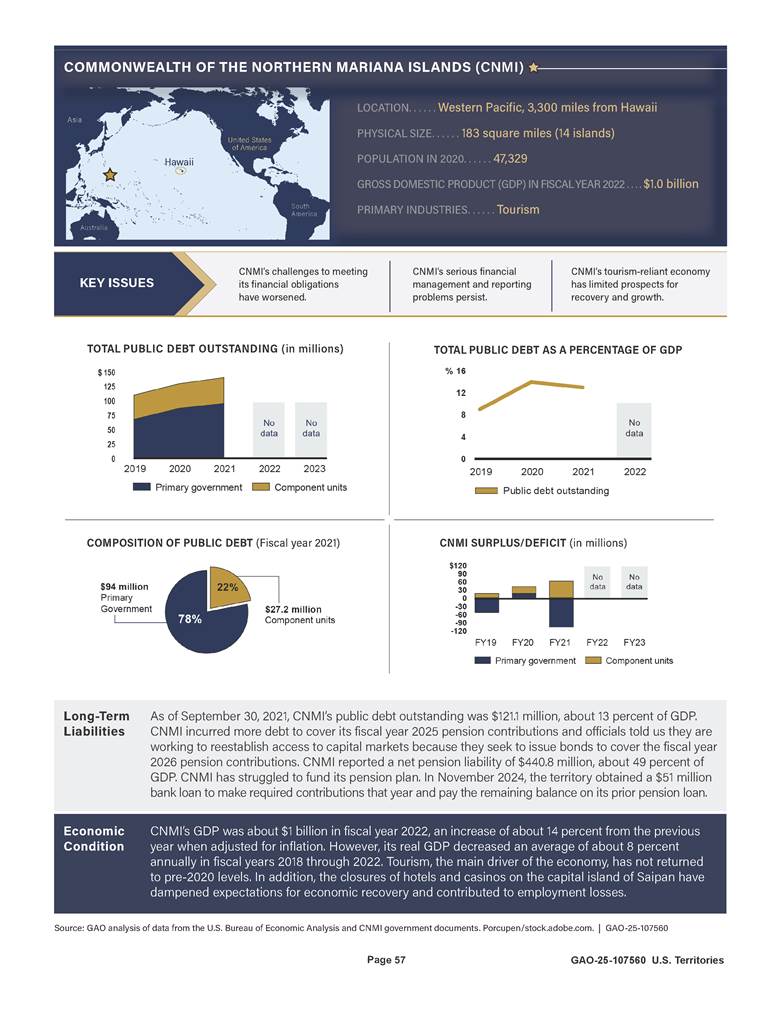U.S. TERRITORIES
Public Debt and Economic Outlook —2025 Update
Report to Congressional Committees
United States Government Accountability Office
For more information, contact Yvonne Jones at JonesY@gao.gov or Latesha Love-Grayer at LoveGrayerL@gao.gov.
Highlights of GAO-25-107560, a report to congressional committees
Public Debt and Economic Outlook – 2025 Update
Why GAO Did This Study
The five permanently inhabited U.S. territories—the Commonwealth of Puerto Rico, Guam, USVI, CNMI, and American Samoa—have borrowed through financial markets to bridge the gap between tax receipts and the financial resources required to fund government programs.
The territories all face challenges to achieving continued economic growth and financial accountability, both of which are key to debt management. GAO has previously reported on some of the common challenges, including (1) the location of the islands, which leads to a high cost of energy and imported goods; (2) increasing vulnerability to frequent and severe episodes of extreme weather; (3) undiversified economies based on few industries with limited job opportunities; and (4) outmigration and population loss.
In 2016, Congress passed and the President signed the Puerto Rico Oversight, Management, and Economic Stability Act. It contains a provision for GAO to review the territories’ public debt every 2 years. This is the fifth report in this series.
In this report, for each of the five territories, GAO presents public debt figures and describes risk factors that may affect their ability to repay public debt, among other updates. GAO analyzed audited financial statements for fiscal years 2020 through 2023, as available.
GAO also reviewed demographic and economic data and interviewed officials from the territories’ governments.
What GAO Found
The U.S. territories’ levels of public debt vary, along with the factors that affect each of their capacities for economic growth and debt repayment. To assess their ability to repay debt, GAO used the most recently available audited financial statements. Audited financial statements for some territories are almost 2 years late, and independent auditors have identified issues that raise data reliability concerns for the available statements. These financial reporting limitations can lead to poor financial decisions and lost access to capital markets.
Geographic Locations of U.S. Territories

Commonwealth of Puerto Rico: As of June 30, 2022, total public debt outstanding was $52.8 billion, 47 percent of gross domestic product (GDP). Negotiations and litigation to restructure the electric utility debt are ongoing, and the utility has been struggling to make its pension payments in the meantime.
Guam: As of September 30, 2023, total public debt outstanding was $2.5 billion. 2023 GDP data are not available, but the fiscal year 2022 total public debt was $2.6 billion, about 38 percent of GDP. Its tourism industry has not returned to pre-COVID-19 levels, but U.S. military investment is bolstering the economy.
U.S. Virgin Islands (USVI): As of September 30, 2021, total public debt outstanding was more than $2.2 billion, or 50 percent of GDP. USVI’s electric utility has critical financial and operational problems, which create challenges for residents and can inhibit economic development.
Commonwealth of the Northern Mariana Islands (CNMI): As of September 30, 2021, total public debt outstanding was $121.1 million, about 13 percent of GDP. Its tourism-reliant economy has limited prospects for recovery, and the challenges to meet its financial obligations have deepened.
American Samoa: As of September 30, 2023, total public debt outstanding was $145.4 million. While 2023 GDP data are not available, the fiscal year 2022 total public debt was $152.4 million, about 18 percent of GDP. Its continued economic reliance on a single tuna cannery presents risks.
|
Abbreviations |
|
|
Puerto Rico |
Commonwealth of Puerto Rico |
|
CNMI |
Commonwealth of the Northern Mariana Islands |
|
FOMB |
Financial Oversight and Management
Board for |
|
FY |
fiscal year |
|
GDP |
gross domestic product |
|
GNP |
gross national product |
|
Moody’s |
Moody’s Ratings |
|
OPAL |
Oficina de Presupuesto de la Asamblea Legislativa |
|
PREPA |
Puerto Rico Electric Power Authority |
|
PROMESA |
Puerto Rico Oversight, Management, and Economic Stability Act |
|
S&P |
S&P Global Ratings |
|
BEA |
U.S. Bureau of Economic Analysis |
|
USVI |
U.S. Virgin Islands |
|
WAPA |
USVI Water and Power Authority |
This is a work of the U.S. government and is not subject to copyright protection in the United States. The published product may be reproduced and distributed in its entirety without further permission from GAO. However, because this work may contain copyrighted images or other material, permission from the copyright holder may be necessary if you wish to reproduce this material separately.
June 30, 2025
The Honorable Mike Lee
Chairman
The Honorable Martin Heinrich
Ranking Member
Committee on Energy and Natural Resources
United States Senate
The Honorable Bruce Westerman
Chairman
The Honorable Jared Huffman
Ranking Member
Committee on Natural Resources
House of Representatives
The five permanently-inhabited U.S. territories—the Commonwealth of Puerto Rico, Guam, the U.S. Virgin Islands (USVI), the Commonwealth of the Northern Mariana Islands (CNMI), and American Samoa—continue to emerge from the challenging economic conditions resulting from the COVID-19 pandemic and recover from severe weather events. Each of these territories faces challenges to achieving continued economic growth and financial accountability, both of which are key to debt management.
The Puerto Rico Oversight, Management, and Economic Stability Act (PROMESA) includes a provision for us to review the public debt of each U.S. territory every 2 years.[1] We issued reports on the territories’ public debt in October 2017, June 2019, June 2021, and June 2023.[2] For each of the five territories, this report updates information from our prior reports on (1) trends in public debt and composition; (2) trends in surpluses and deficits, including changes in revenue and expenses and their composition; and (3) risk factors that may affect each territory’s ability to repay public debt.
We analyze each territory as a distinct entity and report the results of our three objectives separately for each territory because the context related to each can vary, including differences in size, population, geography, and economies. We present the territories in order of the size of their respective economies, as measured by gross domestic product (GDP): Puerto Rico, Guam, USVI, CNMI, and American Samoa.[3] Each section begins with a summary page, highlighting the key issues and statistics that are most salient to each territory’s fiscal condition.
|
The primary government is any state or local government or special–purpose government with a separately elected governing body that is legally separate and fiscally independent of other state and local governments. Component units are legally separate entities for which the primary government is financially accountable. A component unit may be a governmental organization, a nonprofit corporation, or a for-profit corporation. Source: Government Accounting Standards Board. | GAO‑25‑107560 |
To describe trends in public debt, we analyzed financial data reported in each territory’s audited government-wide financial statements for the most recent fiscal years available as of June 1, 2025.[4] To provide consistency, we generally compared the most recent financial data available to the same data from 2 years prior. Although some territories may have more recent unaudited financial data, we generally use audited financial statement data because they are the most reliable data available. Since our prior report of June 2023, Puerto Rico issued audited financial statements for fiscal year 2022; Guam for fiscal years 2022 and 2023; USVI for fiscal years 2020 and 2021; CNMI for fiscal year 2021; and American Samoa for fiscal years 2022 and 2023. Government-wide financial statements include separate financial information for the territories’ primary government and component units (see sidebar).[5]
To describe recent trends in territories’ surpluses and deficits, we analyzed revenue and expense data for primary governments and component units from each territory’s audited government-wide financial statements. If total revenues exceeded total expenses, a territory would report a surplus for that fiscal year. On the other hand, if total expenses exceeded total revenues, a territory would report a deficit.[6]
Timely audited financial statements were not available from all territories. Accordingly, to provide more recent context about public debt and revenue and expenses, we interviewed officials from each of the five territorial governments, including departments of finance or treasury.
To determine risk factors that may affect each territory’s ability to repay its debt, we obtained and reviewed relevant documentation, reports, and analyses from the territorial governments and rating agencies. Because economic growth is key to debt sustainability, we also analyzed the most recently available GDP estimates from the U.S. Bureau of Economic Analysis (BEA) from 2013 to 2022 and population estimates from the U.S. Census Bureau from the 2010 and 2020 censuses.[7] For Puerto Rico, we analyzed the most recently available GDP and gross national product (GNP) estimates from the Puerto Rico Planning Board from 2014 to 2023.[8] We also interviewed officials from the Department of the Interior’s Office of Insular Affairs, which provides grants and technical assistance and support to the territories.
As a part of our analysis of risk factors affecting territories’ abilities to repay public debt, we also present available information on each territory’s liabilities for pensions and other postemployment benefits, since these are a fiscal risk not accounted for in our calculation of total public debt outstanding. We also include analysis of each territory’s financial management and reporting practices, given their importance for making informed financial decisions, maintaining access to capital markets, and managing federal awards.
To understand the reliability of financial information from each territory, we reviewed independent auditors’ reports on the territories’ annual financial statements and the types of opinions they expressed. To understand the territories’ financial management and reporting practices, we reviewed the auditor’s reports on the territories’ compliance with program requirements for each major federal award program. We also reviewed the auditor’s reports on internal control and any identified audit findings. Additionally, we assessed the timeliness of the territories’ audited financial reports. We also interviewed each territory’s independent auditor.
We traveled to Puerto Rico, USVI, and CNMI to conduct our audit work, which we selected based in part on changes in their fiscal conditions since our last update in 2023. We conducted our work with American Samoa and Guam virtually. We conducted this performance audit from April 2024 to June 2025 in accordance with generally accepted government auditing standards. Those standards require that we plan and perform the audit to obtain sufficient, appropriate evidence to provide a reasonable basis for our findings and conclusions based on our audit objectives. We believe that the evidence obtained provides a reasonable basis for our findings and conclusions based on our audit objectives.
Background
Geography and Economic Activity in U.S. Territories
Puerto Rico and USVI are located in the Caribbean near both the mainland U.S. and Central and South America. Guam, CNMI, and American Samoa are located across stretches of the south and west Pacific. All five territories lie in strategic shipping and military locations. The territories comprise approximately 0.1 percent of the U.S. land mass but 6.1 percent of the U.S. territorial waters. As figure 1 shows, Puerto Rico and USVI in the Caribbean Sea are geographically much closer to the U.S. capital in Washington, D.C. than the Pacific territories are.

Guam, USVI, CNMI, and American Samoa are small island areas with commensurately
small economies. In 2022, each of these four territories had a GDP level lower
than that of all 50 U.S. states (see fig. 2).

Financial Accountability Responsibilities of Management, Auditors, and Federal Agencies
A key part of financial accountability is transparency and the availability of reliable and timely information to policymakers, oversight entities, and the public. Financial reporting by state and local governments is used for economic, social, and political decisions and in assessing accountability. Reliable and timely financial statements also provide valuable information to government creditors and investors considering investing in municipal bonds.
|
Internal control is a process effected by an entity’s oversight body, management, and other personnel that provides reasonable assurance that the objectives of an entity will be achieved. Source: GAO Standards for Internal Control in the Federal Government. | GAO‑25‑107560 |
Territorial governments—similar to states and municipalities—publish annual financial statements. The territories’ management is responsible for preparing these statements and designing, implementing, and maintaining internal controls relevant to the timely preparation and fair presentation of the financial statements. Strong internal controls over financial reporting help ensure financial statements are free from material misstatement, whether due to error or fraud. Management is also responsible for designing, implementing, and maintaining a system of internal controls to reasonably ensure compliance with the territories’ federal award program requirements.
In addition to facilitating timely and reliable financial reporting and compliance with federal award requirements, an effective internal control system helps provide reasonable assurance that the territory’s financial and program objectives will be achieved. It also helps the territorial governments and their managers adapt to shifting environments, evolving demands, changing risks, and new priorities.
|
Questioned Cost is a cost that is questioned by the auditor because (1) there was a violation or possible violation of a statute, regulation, or the terms and conditions of a federal award; (2) the cost is not supported by adequate documentation; or (3) the cost appears unreasonable and does not reflect the actions a prudent person would take in the circumstances. Source: 2 C.F.R. § 200.1. | GAO‑25‑107560 |
Each territory undergoes an annual single audit, which is an audit of the territory’s financial statements and federal awards.[9] Single audit reporting packages are generally required to be submitted nine months after the territories’ fiscal year end.[10] Independent auditors conducting the single audit determine if the financial statements are presented fairly in accordance with U.S. generally accepted accounting principles. Auditors express multiple opinions on the territories’ combined financial statements, one for each opinion unit.[11] Auditors also express an opinion on the territories’ compliance with the applicable program requirements for each major federal award program. If auditors identify compliance issues that have a direct and material effect on a certain major federal award program, they will issue a modified opinion on that specific program.
As part of the single audit, auditors also report any deficiencies they identify in the territories’ internal control over financial reporting (known as financial reporting audit findings) and on any issues related to the management of the territories’ federal award programs (known as federal award audit findings). Among other issues, federal award findings include auditor-identified deficiencies in internal control over the territories’ major federal award programs. When applicable, auditors will also identify and report on questioned costs associated with federal award audit findings. For all audit findings, auditors will provide the territory’s management with recommendations for corrective action to resolve them.
Federal agencies are responsible for providing oversight of the federal awards they provide and use the territories’ single audit results to help ensure federal funds are properly used in accordance with applicable requirements. Among other responsibilities, federal awarding agencies must monitor the timeliness of the territories’ single audits, follow up on the territories’ corrective actions in response to federal award audit findings, and determine if any questioned costs should be sustained (disallowed) or reinstated (allowed). Questioned costs that are disallowed must be returned to the federal government. Federal awarding agencies also have discretion to impose additional award requirements or even withhold funding to territories with a history of unresolved single audit issues.
The Territories Issue Debt as a Financial Management Tool
|
Municipal bonds are debt securities issued by states, counties, and other governmental entities to fund day-to-day obligations and to finance capital projects such as building schools, highways, or sewer systems. Investors buying municipal bonds are, in effect, lending money to the bond issuer in exchange for a promise of regular interest payments, and the return of the original investment—the principal—when the bond matures. Source: Securities and Exchange Commission. | GAO‑25‑107560 |
Similar to U.S. states and municipalities, the territories’ primary governments and component units can issue bonds to borrow money through financial markets. Borrowing is a common financial management tool for governments to bridge the gap between tax receipts and the financial resources required to fund government programs. Borrowing also provides a government with the flexibility to finance long-term investments, such as building schools, roads, and hospitals.
For the purposes of this report, total public debt outstanding refers to the sum of bonds and other debt held by and payable to the public. Marketable debt securities—primarily bonds with long-term maturities—are the main vehicle by which the territories access capital markets. Our definition of public debt outstanding also includes other debt payable, which may be marketable notes issued by territorial governments, nonmarketable intragovernmental notes, notes and loans held by local banks, federal loans, and intragovernmental loans. Liabilities related to retirement benefits, such as pension payments to retirees, are not included in our definition of public debt, but are discussed as part of the risk factors that affect each territory’s ability to repay its public debt.
Generally, debt in itself is not an indicator of financial or economic distress. In fact, the ability to issue bonds and access capital markets is often a sign of sound fiscal and economic fundamentals. In theory, borrowing to finance capital improvements, rebuilding efforts, and infrastructure projects would yield economic activity and growth, helping to offset the cost of borrowing. In contrast, in state and local budgeting, issuing debt to finance general government operations may signal fiscal and economic distress. For example, we previously reported that Puerto Rico’s use of bonds to balance its budgets was a key contributor to its debt and fiscal crisis.[12]
In prior reports in this series we highlighted the risks that arise if a government is not able to borrow through capital markets, either because the cost to borrow is prohibitive, or the issuer is in default.[13] Governments that cannot borrow from capital markets do not have access to a source of financing that can provide flexibility to respond to an unexpected event, such as the COVID-19 pandemic or an extreme weather event.
Shifts in Territories’ Revenues and Expenses Drive Changes in Surpluses and Deficits
Territories’ surpluses and deficits can vary considerably from year to year as expenses and revenues shift. Like state and municipal governments, territorial governments spend money on a variety of services and projects. These include general government expenses as well as services such as education, public housing and welfare, and public safety. Territories collect revenues from individual and business taxes, grants, and other sources.
Federal assistance is a major component of revenue for the territories. Combined, the territories receive billions in federal grants annually for activities such as health care, disaster recovery, and education. As we previously reported, federal agencies allocated more than $32 billion in COVID-19 relief funding to the territories as of May 2023.[14] For American Samoa and CNMI, the total allocations received exceeded their pre-pandemic (fiscal year 2019) GDPs (see table 1).
|
Territory |
Total COVID-19 Relief Allocations (billions of dollars) |
Fiscal Year 2019 Gross Domestic Product (billions of dollars) |
|
Commonwealth of Puerto Rico |
$24.8 |
$105.1 |
|
Guam |
$2.7 |
$6.3 |
|
U.S. Virgin Islands |
$1.5 |
$4.1 |
|
Commonwealth of the Northern Mariana Islands |
$1.9 |
$1.2 |
|
American Samoa |
$1.3 |
$0.6 |
|
Total |
$32.1 |
- |
Source: GAO analysis of appropriations, federal agency allocations, U.S. Bureau of Economic Analysis data, and Puerto Rico Planning Board data. | GAO‑25‑107560
Notes: Total allocations include COVID-19 relief funding for which U.S. territory government agencies were the recipients. Allocation data were collected between May 2022 and May 2023, prior to the rescission of unobligated funds in a number of COVID-19 relief programs under the Fiscal Responsibility Act of 2023 in June 2023. See Pub. L. No. 118-5, div. B, tit. I, 137 Stat. 10, 23–30 (2023). Allocations do not sum to total due to rounding. COVID-19 relief funding awarded directly to local governments is not included.
As federal COVID-19 programs wind down, territorial governments are now readjusting their budgets and, in some cases, face challenges identifying long-term funding sources to replace this temporary assistance. The International Monetary Fund has found that disbursements of emergency spending like these can heighten volatility in revenue and expenditures.[15] As past patterns of spending and revenue may no longer be a good predictor of future cash flows, the increased uncertainty can pose challenges for managing budget execution.
Population Decline, Financial Management Issues, and Other Factors Pose Risks to Territories’ Abilities to Repay Debt
Economic and other factors present risks to territories’ abilities to manage their debt. Fiscal risks refer to responsibilities, programs, and activities that may legally commit or create the expectation for future government spending. Fiscal risks may be explicit in that the government is legally required to fund the commitment, or implicit in that a risk arises not from a legal commitment, but from current policy, past practices, or other factors that may create the expectation of future spending.
We have previously reported on some of the common economic challenges the territories face, which present risks to their ability to manage public debt. These challenges include (1) the location of the islands, which leads to the high cost of energy and imported goods; (2) increasing vulnerability to frequent and severe episodes of extreme weather; (3) undiversified economies based on few industries with limited job opportunities; and (4) outmigration and population loss.[16]
Each of the U.S. territories faces risks from changes in their populations. All five territories experienced population decline between 2010 and 2020, according to the most recent data available from the U.S. Census (see table 2).
|
Territory |
Population in 2020 |
Population change between 2010 and 2020 |
|
Commonwealth of Puerto Rico |
3,285,874 |
12% decrease |
|
Guam |
153,836 |
3% decrease |
|
U.S. Virgin Islands |
87,146 |
18% decrease |
|
Commonwealth of the Northern Mariana Islands |
47,329 |
12% decrease |
|
American Samoa |
49,710 |
10% decrease |
Source: GAO analysis of Census data | GAO‑25‑107560
|
Gross Domestic Product is a comprehensive time-series measure of economic activity for a territory, specifically the value of the goods and services produced within its border. Source: U.S. Bureau of Economic Analysis. | GAO‑25‑107560 |
These demographic trends pose a challenge as population decline among working-age residents means lower employment tax revenue and economic activity.
The status of a territory’s economy may also present a risk to its ability to successfully manage debt. Economic activity—as measured by GDP—in the territories reflects the structures of their economies, the influx of federal disaster funds and pandemic-related financial assistance, and the severity of the impact of the COVID-19 pandemic. A territory’s economy affects its fiscal position, and thus its ability to repay debt and access capital markets.
Liabilities for pension benefits represent an explicit fiscal risk. We have previously reported that several territories have faced challenges funding their pension benefits.[17] In addition to pension benefits, governments may also provide retired employees other benefits, such as health care benefits, life and disability insurance, as well as other services. These are referred to as “other postemployment benefits” or OPEB liabilities in the government-wide financial statements.[18] Like most states and municipalities, the territories pay for these benefits on an ongoing basis rather than from a dedicated funded system in which benefits are financed by prior investments in a pension fund. Given that health care costs are increasing at a rate faster than inflation, liabilities for other postemployment benefits could present a significant fiscal risk to the government. Obligations to provide pension and other postemployment benefits can significantly affect a territory’s financial health and may impair its ability to make debt service payments on outstanding bonds and other debt held by and payable to the public.
Financial management and reporting issues also pose risks, as the territories’ independent auditors continue to identify a number of long-standing issues during annual single audits. For several of the territories, this includes poor audit opinions, numerous audit findings, and questioned federal award costs. For USVI and CNMI, the severity of the reported issues raises concerns about the reliability of these territories’ financial statements. Further, some territories have struggled to issue timely financial statements and other required single audit reports. For example, fiscal year 2022 single audit reports for USVI and CNMI are currently delayed by almost 2 years as of June 1, 2025. We discuss these financial management and reporting issues further throughout this report.
Without timely and reliable financial reporting, the territories risk making poor financial decisions, including those pertaining to debt management. The territories also risk losing access to capital markets because there is insufficient information to support credit ratings. Furthermore, as federal funding makes up a large portion of the territories’ revenue, mismanagement of federal awards poses a financial risk for the territories if federal funding is disallowed or restricted.
As previously noted, we are reporting the results of our work on our three objectives separately for each of the five territories. Each of the five territory sections begins with a summary of key issues and data. We then address the results of our work, by objective, for each of the five territories.
Puerto Rico
Puerto Rico Has Restructured Much of its Debt but Electric Utility Debt Remains in Negotiation
As of August 2024, Puerto Rico has restructured $64.7 billion of debt since the Puerto Rico Oversight, Management, and Economic Stability Act (PROMESA) was enacted in 2016.[19] The total restructured debt immediately after restructuring was $28.2 billion, and was about $24.1 billion as of March 2025, according to government officials. Since our last update, Puerto Rico has restructured several smaller debts under debt restructuring mechanisms established by PROMESA, but the final major restructuring for the Puerto Rico Electric Power Authority (PREPA) is still in process.[20] PREPA’s in-court restructuring began in 2017, when PREPA filed for protections under Title III of PROMESA. In 2022, the Financial Oversight and Management Board for Puerto Rico (FOMB) filed an initial proposed Plan of Adjustment for PREPA.[21]
The primary government of Puerto Rico does not have short term plans to issue debt unrelated to restructuring or refinancing, according to government officials. As of April 2025, the primary government does not have a credit rating. Officials told us that they will not pursue a rating until PREPA’s restructuring is complete, though they have been regularly meeting with the principal rating agencies.
Puerto Rico’s fiscal year 2022 audited financial statements show that as of June 30, 2022, the territory’s total public debt outstanding was about $52.9 billion, or 47 percent of its fiscal year 2022 GDP and 67 percent of its fiscal year 2022 GNP. The total public debt was 11 percent lower in fiscal year 2022 compared to fiscal year 2020. The primary government held more of the territory’s public debt than did the component units. Of the component units, the power utility, PREPA, held the largest share as of fiscal year 2022 (see fig. 3).

Notes: Our calculation of public debt outstanding includes the sum of bonds and other debt payable, which may be marketable notes issued by territorial governments, nonmarketable intragovernmental notes, notes and loans held by local banks, and federal and intragovernmental loans. Fiscal year 2022 is the most recent year for which audited financial data are available. Numbers may not add due to rounding.
Puerto Rico Reported a Surplus in Fiscal Year 2022, After 2 Years of Deficits
Our analysis of Puerto Rico’s fiscal year 2022 audited financial statements shows a total combined surplus of $1.9 billion in fiscal year 2022. This is a reversal from the prior 2 years, which had deficits of $424.1 million in fiscal year 2021 and $2.3 billion in fiscal year 2020.
· The primary government had a $2.3 billion surplus in fiscal year 2022, a $2.8 billion improvement from its fiscal year 2020 deficit, as increases in revenue outpaced increases in expenses.
· The component units had a deficit of $355.4 million in fiscal year 2022, a $1.5 billion improvement over the deficit in fiscal year 2020, as increases in revenue outpaced increases in expenses. See figure 4.

Notes: FY 2022 is the most recent year for which audited financial
data are available. Puerto Rico’s primary government later restated its FY 2019
and FY 2020 revenues and expenses. As the differences were not material, we
include the original audited revenues and expenses in this report. Special and
extraordinary one-time gains related to the Puerto Rico Oversight, Management,
and Economic Stability Act Title III and VI proceedings and debt forgiveness in
FY 2019 and FY 2022 have been excluded from the revenue figures included in our
report. If these special and extraordinary items were included in Puerto Rico’s
revenues, the primary government would have a $13.1 billion surplus in FY 2019
and a $8.2 billion surplus in FY 2022 and the component units would have a $2.4
billion surplus in FY19 and a $7.7 million deficit in FY 2022
Revenues
In fiscal year 2022, Puerto Rico’s total combined revenue was $45.8 billion, an increase of 24 percent from fiscal year 2020.
· In fiscal year 2022, Puerto Rico’s primary government revenue was $34.8 billion, a 14 percent decrease from fiscal year 2021 but an increase of about 24 percent compared to fiscal year 2020. Officials attribute the revenue growth between 2020 and 2022 mainly to increased tax revenues and increased operating grants and contributions.
· Revenue from the component units was 23 percent higher in fiscal year 2022 compared to fiscal year 2020, growing from $9.0 billion to $11.1 billion, as shown in figure 5. According to officials, the increase in revenue was mainly driven by higher service charges for electricity as Puerto Rico’s electric utility, PREPA, passed higher fuel costs for electricity on to its customers.

Note: Fiscal year 2022 is the most recent year for which
audited financial data are available. Puerto Rico’s primary government later
restated its fiscal year 2019 and 2020 revenues. As the differences were not
material, we include the original audited revenues in this report. Special and
extraordinary one-time gains related to the Puerto Rico Oversight, Management,
and Economic Stability Act Title III and VI proceedings and debt forgiveness in
fiscal years 2019 and 2022 have been excluded from the revenue figures included
in our report. If these special and extraordinary items were included, primary
government revenues would increase by $6.3 billion in fiscal year 2019 and $5.9
billion in fiscal year 2022 and component unit revenues would increase by $4.2
billion in fiscal year 2019 and $347.7 million in fiscal year 2022
Expenses
In fiscal year 2022, Puerto Rico’s total combined expenses were $43.9 billion, an 11 percent increase from fiscal year 2020.
· In fiscal year 2022, Puerto Rico’s primary government expenses were $32.5 billion, a 19 percent decrease from fiscal year 2021, but an increase of about 14 percent compared to fiscal year 2020. When comparing fiscal years 2022 and 2020, expenses for public housing and welfare, education, and general government increased the most.
· Expenses for the government’s component units increased 5 percent in fiscal year 2022 compared to fiscal year 2020, growing from $10.8 billion to $11.4 billion. Officials said that this increase is largely due to a rise in the cost of fuel used to generate electricity. At Puerto Rico’s electric utility, PREPA, increases in total expenses outpaced increases in service charge revenues. See figure 6.

Note: Fiscal year 2022 is the most recent year for which audited financial data are available. Puerto Rico’s primary government later restated its fiscal year 2019 and 2020 expenses. As the differences were not material, we include the original audited expenses in this report.
Puerto Rico Continues to Strengthen its Fiscal Position but Electric Utility Status and Other Risks Remain
Puerto Rico’s GDP Has Grown, but Recent Indicators Are Less Positive
Puerto Rico’s economy grew in fiscal year 2024, continuing three years of modest growth. The territory’s GDP in fiscal year 2024, the most recent data available, was $125.8 billion.[22] Its GNP in that year was $85.6 billion. Between fiscal years 2023 and 2024 Puerto Rico’s real GDP increased 3 percent, and its real GNP increased 2 percent (see fig. 7). Puerto Rico’s annual real GDP growth between fiscal years 2020 and 2024 averaged 0.6 percent, and its annual real GNP growth averaged 0.7 percent. This is a reversal from the prior period (fiscal years 2016 through 2019), during which both the territory’s real GDP and real GNP on average declined about 2 percent annually.
Figure 7: Puerto’s Real Gross Domestic Product and Real Gross National Product in Fiscal Years 2014 Through 2024 (in 2017 dollars)

According to government officials, the influx of federal funds provided to mitigate the effects of Hurricanes Irma and Maria in 2017 and of the COVID-19 pandemic contributed to Puerto Rico’s economic growth. Despite recent growth Puerto Rico’s Economic Activity Index was lower for each month between September 2024 and February 2025 than the same month in the previous year, which may indicate the economy is slowing.[23] As stated previously, the strength of a territory’s economy affects its ability to repay debt and access capital markets.
Puerto Rico Is Implementing Strategies to Strengthen Its Fiscal Position
The government of Puerto Rico and FOMB have worked to strengthen Puerto Rico’s fiscal responsibility and thus its fiscal position. FOMB was established by PROMESA to help the territory achieve fiscal responsibility and access to capital markets. To promote fiscal responsibility, FOMB certifies the fiscal plans and annual budget of the government of Puerto Rico, and several of its major component units.
Officials from FOMB expressed concerns about Puerto Rico’s ability to remain fiscally responsible. To support fiscal responsibility, FOMB reviews new legislation to ensure that new laws are consistent with the fiscal plan.[24] Legislation that incurs expenses or reduces revenue without offsetting measures could be found to be inconsistent with the fiscal plan. For example, in 2024, FOMB determined a bill that would have set a new base salary for school cafeteria employees was inconsistent with the fiscal plan because, among other things, the bill did not include corresponding savings or new revenue to offset the additional cost.[25]
The government adopted a debt management policy in 2022 to help guard against unsustainable borrowing. The policy generally (1) requires that new long-term issuances of tax-supported debt must be for capital improvements or refinancing for savings and (2) specifies that maximum annual tax-supported debt service cost cannot exceed 7.94 percent of the average debt policy revenues from the preceding 2 fiscal years.[26] The government has not issued any tax-supported debt unrelated to restructuring since it adopted the policy, according to government officials.
The creation of the Legislative Assembly Budget Office, or Oficina de Presupuesto de la Asamblea Legislativa (OPAL) also marks an elevated focus on fiscal responsibility. Created in 2023 by the Puerto Rican legislature, OPAL provides estimates of the fiscal effect for legislative proposals. These estimates can help the legislature better understand how proposed measures would affect levels of revenue or expenses. FOMB has encouraged the legislature not to move bills forward until they have been analyzed for fiscal effect by OPAL. However, the use of these estimates in the decision-making process is currently at the discretion of the legislature. OPAL officials told us they produced 185 estimates in fiscal year 2024, including estimates for 11 bills that became law, while 180 laws were enacted without estimates. Government officials told us that it is common for the legislature to pass bills that OPAL warned would have adverse fiscal consequences.
Puerto Rico’s Electric Utility and Other Factors Present Fiscal Risks
Electric Utility
While Puerto Rico has restructured most of its debt, PREPA bondholders and FOMB have not reached an agreement to settle the electric utility’s debt. FOMB filed its proposed plan for PREPA’s restructuring in December 2022. In June 2024 the First Circuit Court of Appeals ruled that PREPA’s bondholders had a lien and non-recourse claim on PREPA’s net revenues, a change that increased the bondholders’ allowable claim from $2.4 billion to $8.5 billion.[27] FOMB moved to reargue this decision, but after granting one rehearing motion the court declined further rehearing in December 2024.
PREPA has been struggling to make its pension payments. PREPA’s pension funding was exhausted in December of 2024, and it no longer had the resources to provide monthly pension benefits to current and former employees. As of May 2025, the primary government has provided PREPA with $375 million in loans, which will cover PREPA’s pension payments through June 2025. In response, FOMB has suggested increasing electricity prices so that PREPA can meet its pension obligations in the long term.
Puerto Rico’s power grid has still not recovered from the damage caused by the 2017 hurricanes, and electricity continues to be relatively expensive. Residents in Puerto Rico lose power more often than residents in any state.[28] Equipment failures caused several major outages in 2024.[29] For example, on December 31, 2024, 90 percent of PREPA customers lost power when an underground power line failed.[30] In January 2025, the average price of electricity was about 29 cents per kilowatt hour, about 80 percent higher than the average price in the mainland United States in the same period, according to the U.S. Energy Information Administration.[31]
The Puerto Rican government and PREPA have been working on an energy sector transformation since 2018. As part of the transformation, LUMA Energy—a private company—assumed operation of PREPA’s electricity transmission system in 2021. Genera PR—a separate private company—began to operate, maintain, and decommission PREPA’s aging power-generation assets in 2023. Additionally, Puerto Rico’s then Governor-elect established a working group in December 2024 to review Puerto Rico’s energy policy. In January 2025, the Governor created a new position—energy czar—to oversee Puerto Rico’s grid recovery, which includes supervising Genera PR and LUMA Energy. Figure 8 shows a transmission tower in Puerto Rico.

Improving the reliability and cost of Puerto Rico’s electricity is critical to attract and retain business and to support sustained economic growth. Puerto Rico has made efforts to reform its energy sector. Rising energy prices are a risk to balancing spending and revenue in coming years, according to Puerto Rico officials. Officials also told us that energy prices may pose more of a risk to Puerto Rico than to the mainland because the territory is more dependent on fossil fuels to generate electricity.
Climate Risks
Increasingly powerful storms pose a risk, according to Puerto Rico officials. For example, Hurricanes Irma and Maria in September 2017 caused widespread damage to critical infrastructure, livelihoods, and property. Additionally, a 2024 report from Puerto Rico’s Department of Natural and Environmental Resources estimated that Puerto Rico will lose $380 billion in GDP by 2050 if global temperatures increase by 2 degrees Celsius above pre-industrial levels.[32]
Population Changes
Population decline and an aging population remain concerns. Puerto Rico’s population was 3.2 million in 2024, according to census data. In 2020, Puerto Rico’s population increased, and in subsequent years resumed declining, but at a slower rate than the previous historic trend. Officials from OPAL estimated that if population had remained stable, rather than decreasing between 2008 and 2022, the economy would have grown 1.4 percent rather than contracting 15.8 percent. Meanwhile, Puerto Rico’s population is older on average than the population of the mainland United States. Government officials recognized that future population loss poses a risk to Puerto Rico’s continued economic growth and stability, as fewer working-age residents leads to lower employment tax revenue and diminished economic activity. These officials said they remain optimistic that increased economic growth and infrastructure improvements may retain and attract residents.
Disaster Assistance
Officials told us that Puerto Rico’s recent economic growth has been fueled in part by federal funds provided to rebuild after Hurricanes Maria and Irma and to respond to the COVID-19 pandemic. Officials expressed concern that the wind down of these funds could diminish commercial and economic activity, which would lower government revenue.
Pension and Other Postemployment Benefit Liabilities
As stated earlier, pension and other postemployment benefit liabilities represent a fiscal risk. Puerto Rico’s total net pension liability in fiscal year 2022 was $55.1 billion, a 9 percent increase from fiscal year 2020.[33] The territory’s total liability for other postemployment benefits in fiscal year 2022 was $1.9 billion, a 2 percent decrease from fiscal year 2020.
Liability for both pensions and postemployment benefits for the primary government and component units totaled $57.0 billion in fiscal year 2022, representing 50 percent of Puerto Rico’s GDP in fiscal year 2022, and 73 percent of its GNP. Government officials told us they expect these liabilities to decrease in the future due to reductions in benefits that were part of the debt restructuring.
Puerto Rico established a pension trust in 2022 as part of the Commonwealth’s Plan of Adjustment to support future pension payments. The trust will be funded through annual contributions until fiscal year 2031, according to government officials. The payments are calculated using a formula based on Puerto Rico’s annual surpluses and is projected to be fully funded (i.e., the pension fund assets will be equal to or greater than the estimated liability) by fiscal year 2039. The government will be able to withdraw funds to help pay for pensions under certain conditions starting in fiscal year 2032, according to government officials. As of April 2025, Puerto Rico has contributed a total of $3.4 billion to the pension reserve trust, with the most recent payment of $906 million made in November 2024, according to government officials.
Puerto Rico Continues to Have Some Financial Management and Reporting Issues
While Puerto Rico has made some improvement in the timeliness of its audited financial statements, the territory’s continued delays and issues obtaining clean audit opinions present a risk. Several of the departments included in Puerto Rico’s primary government also have recurring audit findings related to financial reporting and federal awards, along with some questioned costs.[34] As stated previously, timely and reliable financial reporting is important to ensure territories can make informed debt management decisions and access capital markets if needed.
Timeliness. Puerto Rico has made some progress in issuing more timely audited financial statements, but the territory’s fiscal year 2021 and 2022 statements were delayed. Both of these financial statements were issued about 22 months after the end of their respective fiscal years.[35] As of June 1, 2025, the territory had not yet issued its fiscal year 2023 or 2024 statements. Puerto Rico officials stated that these delays were due to their inability to obtain timely financial information from PREPA, which the government includes in its government-wide financial statements.
Audit opinions. In Puerto Rico’s last two completed audits, fiscal years 2021 and 2022, the territory received a disclaimer of opinion on its business-type activities.[36] Puerto Rico received this opinion because auditors were unable to obtain sufficient appropriate audit evidence to conclude that certain financial balances and activities in its unemployment insurance fund were free of material misstatement. Of the individual departments we reviewed, all received qualified audit opinions on a significant portion of their major federal award programs, meaning auditors found compliance issues that had a direct and material effect on those programs.
Audit findings. Several of the departments included in Puerto Rico’s primary government have serious audit findings that have remained unresolved for at least 2 years. For example, auditors reported that Puerto Rico’s Department of Labor and Human Resources did not have adequate accounting procedures for the reconciliation and analysis of financial transactions and did not properly supervise and train accounting personnel. Among other risks, this increases the likelihood that this department will not adhere to applicable financial reporting regulations or detect budget variances, errors, or fraud on a timely basis. Additionally, auditors for Puerto Rico’s Department of Education reported that inadequate payroll processing controls prevented it from detecting incorrect or duplicate payments to employees in a timely manner. Auditors also reported that this department had inadequate controls related to equipment and property management, including deficiencies in safeguarding, physical inventory, and records maintenance.
Questioned costs. The total expenditures questioned by an auditor—known as questioned costs—associated with the federal award findings was close to $1 million for the three departments we reviewed. While this is a small amount in the context of the territory’s annual budget, these three departments make up a relatively small portion of Puerto Rico’s primary government. If other departments are experiencing federal award management issues, the territory’s total questioned costs could potentially be much higher.
These findings are important for the following reasons:
· Timely and reliable financial data provide important information for investors, policymakers, oversight bodies, and the public on the financial and economic condition of the territory.
· Robust internal controls are important to support managers as they make financial decisions or adapt to shifting environments, evolving demands, changing risks, and new priorities as they arise.
· Strong controls over compliance help ensure federal award programs meet objectives and are compliant with applicable laws and regulations. Furthermore, they reduce the risk that territories will have to return disallowed costs or be excluded from future federal funding due to noncompliance with federal award program requirements.
Puerto Rico has begun to implement an enterprise resource planning system, which is intended to streamline the government’s financial, supply chain, human capital management, and payroll systems. Puerto Rico’s auditors said they expect full implementation of the system will resolve a significant portion of Puerto Rico’s issues with financial reporting and internal controls. The government began implementing the system in 2022, but the implementation has faced delays. To address delays, the government revised its implementation to prioritize the essential financial functions, focusing on the financial management and supply chain modules.
Guam
As Fiscal Position Improves, Guam Plans to Issue New Debt to Finance Infrastructure Projects
Guam officials told us they plan to issue bonds for infrastructure and capital improvement projects in the near future. For example, they plan to issue bonds for a new high school after they award the construction contract in late June 2025. The primary government and component units issued bonds in fiscal years 2022, 2023, and 2024 to refinance existing debt, reducing its interest payments on outstanding debt.
In January 2024, Moody’s Ratings, a company that provides credit ratings and risk analyses to help investors analyze credit risk, upgraded the government of Guam’s credit rating from a substantial credit risk to a moderate credit risk.[37] According to Moody’s, the new rating reflects significant improvement in the government’s financial position due to federal support and military construction activity. In February 2025, S&P Global Ratings, another company that provides credit ratings, assigned a positive outlook to all ratings of the government of Guam.[38] S&P has ratings for several of Guam’s bonds, all of which are speculative grade.[39]
According to our analysis of Guam’s fiscal year 2023 audited financial statements, Guam’s total public debt outstanding was $2.5 billion as of September 30, 2023, a 4 percent decrease from fiscal year 2021. Component units held more of the territory’s public debt than the primary government. The water and electric utilities held the largest shares of component unit debt as of fiscal year 2023 (see fig. 9).[40]

Notes: Our calculation of public debt outstanding includes the sum of bonds and other debt payable, which may be marketable notes issued by territorial governments, nonmarketable intragovernmental notes, notes and loans held by local banks, and federal and intragovernmental loans. Fiscal year 2023 is the most recent year for which audited financial data are available. Numbers may not add to 100 due to rounding.
Guam Reported Surpluses in Fiscal Years 2022 and 2023
Our analysis of Guam’s fiscal year 2023 audited financial statements shows a total combined surplus of $66.0 million in fiscal year 2023.
· The primary government had a $78.5 million surplus in fiscal year 2023, a $115.5 million improvement from the fiscal year 2021 deficit, as decreases in expenses outpaced decreases in revenue.
· The component units had a deficit of $12.5 million in fiscal year 2023, a $71.0 million reversal from their fiscal year 2021 surplus, as increases in expenses outpaced increases in revenue, as shown in figure 10.

Note: FY 2023 is the most recent year for which audited financial data are available.
Revenues
In fiscal year 2023, Guam’s total combined revenue was $3.3 billion, a 6 percent increase from fiscal year 2021.
· In fiscal year 2023, Guam’s primary government revenue was almost $2 billion, a decrease of 3 percent from fiscal year 2021. Guam officials said that this decrease in revenue can be mainly attributed to the end of federal grants related to the COVID-19 pandemic.
· Guam’s component unit revenue was $1.3 billion in fiscal year 2023, an increase of 23 percent from fiscal year 2021. Guam officials said that the increase in revenue was largely due to an increase in the price of fuel used to generate electricity, and that this increase was passed on to electricity customers in the form of service charges. At Guam’s electric utility, Guam Power Authority, increases in service charge revenue slightly outpaced increases in total expenses (see fig. 11).

Note: Fiscal year 2023 is the most recent year for which
audited financial data are available.
Expenses
In fiscal year 2023, Guam’s total combined expenses were $3.2 billion, a 4 percent increase from fiscal year 2021.
· In fiscal year 2023, Guam’s primary government expense was $1.9 billion, a decrease of 9 percent from fiscal year 2021. Guam officials said that this decrease in expenses can be largely attributed to decreased spending in response to reduced COVID-19 pandemic-related federal grants.
· Guam’s component unit expense was $1.3 billion in fiscal year 2023, an increase of 32 percent from fiscal year 2021. Guam officials said that the increase in expenses was mainly due to an increase in the price of fuel used to generate electricity (see fig. 12).

Note: Fiscal year 2023 is the most recent year for which audited financial data are available.
Guam’s Economy Shows Continued Signs of Recovery After COVID-19 Pandemic, but Fiscal Risks Remain
Most Recent Data Show Increase in Guam’s GDP
Guam’s economy has continued to recover from the COVID-19 pandemic. Guam’s GDP was $6.7 billion in fiscal year 2022, the most recent year for which data are available.[41] In real terms, this represented economic growth of about 4 percent from the previous year (see fig. 13). Real GDP on average declined 0.6 percent annually between fiscal years 2018 and 2022 and increased 1 percent annually between fiscal years 2013 and 2017. As stated previously, the strength of a territory’s economy affects its ability to repay debt and access capital markets.

Note: The most recent available data are for 2022.
U.S. Military Presence in Guam Has Bolstered the Economy
The U.S. military’s growing presence on the territory provides a stable and increasing source of economic activity. Guam’s location enables it to serve as a strategic hub supporting crucial operations and logistics for U.S. military forces operating in the Indo-Pacific region. Guam hosts three U.S. military bases and, approximately 21,700 military members and their families as of 2020, according to the Department of Defense. According to the Department of Defense, of the amounts Congress appropriated for military construction and family housing for fiscal years 2020 through 2025, the military plans to use a total of $3.9 billion in Guam. This is in addition to the $1.3 billion it used from appropriations for the same purposes for fiscal years 2014 through 2019.[42]
The military’s presence in Guam is expected to expand in coming years. Guam is expecting that the new Marine Corps Base Camp Blaz, which opened in January 2023, will be home to approximately 5,000 Marines (see fig. 14). According to Guam officials, Marines began relocating from Okinawa, Japan, in December 2024.

Recovery of Guam’s Tourism Industry and Other Factors Present Risks
Tourism
Tourism is one of Guam’s primary industries, along with
military-related activities and construction. Due to visitor growth, Guam’s hotel
tax revenue has increased from its pandemic low. Guam collected $29 million in
hotel tax revenues in fiscal year 2023, an increase of 130 percent from a low
of $12 million in fiscal year 2021. However, the fiscal year 2023 hotel tax
revenues were still 36 percent lower than those collected in fiscal year 2019,
prior to the pandemic, reflecting that the tourism industry has not fully
recovered. While tourism remains well below pre-pandemic levels, the government
of Guam’s visitor arrival numbers have continued to increase annually after
reaching a low in 2021, as shown in figure 15.

Economic Risks
Despite its relatively stable GDP, Guam faces several additional risks. In its January 2024 rating action, Moody’s identified several fiscal risks to the territory. These included Guam’s small and concentrated economy and the economy’s heavy reliance on tourism, residents’ low incomes, and what Moody’s considered to be very high long-term government liabilities. A 2019 report created for Guam’s government shows that the island’s infrastructure would be greatly affected by sea-level rise, and that the frequency of strong tropical cyclones will likely increase. Guam officials we spoke with also identified the high cost of living and population loss as fiscal risks. Guam’s population decreased about 4 percent between 2010 and 2020, according to the U.S. Census.
Pension and Other Postemployment Benefit Liabilities
As stated earlier, pension and other postemployment benefit liabilities represent a fiscal risk. Guam’s total net pension liability in fiscal year 2023 was $1.8 billion, a 10 percent increase from fiscal year 2021. Officials said this was partly due to employees joining a new defined benefit plan. Additionally, they stated that there was a loss to the pension plan’s assets, which caused the net liability to increase.
Guam’s total liability for other postemployment benefits, such as health care, in fiscal year 2023 was $2.3 billion, a 9 percent decrease from fiscal year 2021. Officials stated that this was due to a change in the actuarial assumptions used in the plan’s most recent valuations.
Liability for both pensions and postemployment benefits for the primary government and component units totaled $4.1 billion in fiscal year 2023, a 1 percent decrease from fiscal year 2021.[43]
Officials told us that annual contributions to the territory’s pension fund are based on actuarial recommendations. The required contribution rate has recently risen in response to the higher pension liability and is estimated to further increase in the future. Officials expect the pension to be fully funded by 2034 (i.e., the pension fund assets will be equal to or greater than the estimated liability). The government pays other postemployment benefits as they are due.
Guam’s Financial Statements Are Reliable but Some Weaknesses in Internal Control Exist
Guam’s financial statements have consistently been of high quality, according to independent auditors, and the territory has made some progress in addressing its internal control deficiencies. However, the territory has had recent issues with the timeliness of its single audit reports and independent auditors continue to identify significant audit findings and some questioned costs associated with its federal award programs. As stated previously, timely and reliable financial reporting is important to ensure territories can make informed debt management decisions and access capital markets if needed.
Timeliness. Until recently, Guam generally issued its single audit reports on time. However, the territory’s fiscal year 2022 reports were issued about 5 months late, and its fiscal year 2023 reports were issued more than 7 months late. Guam officials stated the delays were partially due to their inability to recruit and retain trained accountants and obtain timely financial information from Guam’s Department of Education. Additionally, officials stated that delays occurred due to a change in independent auditors in fiscal year 2022 and issues with extending the contract with those auditors for fiscal year 2023.
Audit opinions. The territory has consistently received unmodified audit opinions since at least 2010. This means that the independent auditors have determined that the financial information included in Guam’s government-wide financial statements is reliable. However, Guam received a qualified opinion on over half of its major federal award programs in fiscal year 2023, meaning auditors found compliance issues that had a direct and material effect on those programs.
Audit findings. While Guam has made some progress in this area by implementing a new financial management system, it has struggled to remediate several material weaknesses in internal control over financial reporting and compliance identified by its independent auditors.[44] For example, auditors reported that Guam has not performed timely reconciliations, properly recorded certain revenue and expense transactions, completed a comprehensive physical inventory count, consistently provided appropriate supporting documentation, or effectively monitored compliance with all program requirements. These reported issues have resulted in Guam’s noncompliance with a number of federal award program requirements. Additionally, they increase the risk that misstatements and delays may occur in unaudited financial information that is being used to make financial and policy decisions throughout the fiscal year.
Questioned costs. Guam’s questioned costs associated with its federal award findings were $15.5 million in fiscal year 2023, which is 2 percent of the territory’s total federal award expenditures in that year.[45]
These findings are important for the following reasons:
· Timely and reliable financial data provide important information for investors, policymakers, oversight bodies, and the public on the financial and economic condition of the territory.
· Robust internal controls are important to support managers as they make financial decisions or adapt to shifting environments, evolving demands, changing risks, and new priorities as they arise.
· Strong controls over compliance help ensure federal award programs meet objectives and are compliant with applicable laws and regulations. Furthermore, they reduce the risk that territories will have to return disallowed costs or be excluded from future federal funding due to noncompliance with federal award program requirements.
Guam implemented a new financial management system in February 2024, according to officials. The system handles the government of Guam’s financial reporting, as well as other functions such as budget, payroll, human resource, and grants management. Guam’s auditors said they anticipate the system will greatly improve financial reporting. According to officials, the first full year of financial management using the system will be reflected in fiscal year 2025 audited financial statements, with a partial year reflected in the fiscal year 2024 audited financial statements.
U.S. Virgin Islands (USVI)
USVI Issued New Debt in 2025
|
Reliability of U.S. Virgin Islands’ Financial Information Independent auditors have consistently identified issues that raise concerns about the reliability of the U.S. Virgin Islands’ (USVI) financial statements. For example, USVI has struggled to obtain clean audit opinions. We present USVI’s financial statement information from fiscal years 2019 through 2021 because it is the most recent comprehensive data available on the territory’s financial status as of June 1, 2025. However, given the material and pervasive nature of the issues identified, the public debt, revenue, expense, and net pension and other postemployment liability data in our report could be significantly misstated. Source: GAO analysis of the U.S. Virgin Islands’ audited financial statements. | GAO‑25‑107560 |
USVI most recently issued debt in May 2025 in the amount of $150.2 million. The Virgin Islands Transportation and Infrastructure Corporation, a subsidiary of the Virgin Islands Public Finance Authority, issued the debt to finance Federal Highway Administration projects, among other things. Prior to that, the Public Finance Authority issued two series of bonds through a private placement in the amounts of $64.9 million and $18.3 million. These bonds funded a grant for hotel development and related costs. The territory also secured a $100 million line of credit in 2023 to fund disaster-related projects that are reimbursable through federal funding.
USVI officials told us they do not have plans to issue new debt in the near term. The territory has not had an active credit rating since Moody’s withdrew its rating in 2023.[46]
Our analysis of USVI’s fiscal year 2021 audited financial statements—the most recent available—shows that USVI’s total public debt outstanding was more than $2.2 billion, or 50 percent of GDP.[47] This represents a decrease from the territory’s total public debt of about $2.7 billion—66 percent of GDP—in fiscal year 2019.
The primary government is responsible for most of the territory’s public debt. Of the government components, the USVI Water and Power Authority held the largest share, as of fiscal year 2021 (see fig.16).
Figure 16: Composition of the U.S. Virgin Islands’ Public Debt Outstanding, as of September 30, 2021

Note: Our calculation of public debt outstanding includes the sum of bonds and other debt payable, which may be marketable notes issued by territorial governments, nonmarketable intragovernmental notes, notes and loans held by local banks, and federal and intragovernmental loans. Fiscal year 2021 is the most recent year for which audited financial data are available. Numbers may not add due to rounding.
USVI Reported Growing Deficits in Fiscal Years 2020 and 2021
According to its fiscal year 2021 audited financial statements, USVI recorded a deficit of about $484 million that year, an increase from the prior year’s deficit of $97.8 million.[48] In fiscal year 2019, the territory had a surplus of $7.1 million.
USVI’s growing deficits are due to declining fiscal positions of both the primary government and its component units.
· The primary government has had an increasing deficit for the most recent 3 fiscal years for which data are available, as increases in expenses have continued to outpace increases in revenue.
· Component units had surpluses in fiscal years 2019 and 2020 before falling into deficit in fiscal year 2021. When comparing fiscal years 2019 and 2020, decreases in revenue slightly outpaced decreases in expenses. In fiscal year 2021, revenues decreased while expenses increased compared to the prior fiscal year.
Figure 17 shows the territory’s primary government and component units’ surpluses or deficits by fiscal year.

Note: FY 2021 is the most recent year for which audited
financial data are available. USVI’s FY 2019, FY 2020, and FY 2021 revenues and
expenses do not include special items related to gains from pandemic
assistance, debt cancellation, insurance recoveries, and losses on the sale of
assets. If these special items were included in USVI’s revenues and expenses,
primary government deficits would have been $190.5 million in FY 2019, $100.2
million in FY 2020, and $178.8 million in FY 2021 and component unit surpluses
would have been $232.3 million in FY 2019, $109.9 million in FY 2020, and
$155.0 million in FY 2021.
Revenues
Over the most recent years for which data are available, USVI’s total revenue declined slightly from about $3.7 billion in fiscal year 2019 to about $3.5 billion in fiscal year 2021. As shown in figure 18, the primary government’s revenues increased over this period, while component unit revenue decreased and then plateaued. USVI officials told us that the most significant changes in revenue in recent years were due to federal assistance in the wake of the 2017 hurricanes and COVID-19 pandemic. They said that the assistance for both of these events resulted in revenue increases for the territory.

Note: Fiscal year 2021 is the most recent year for which audited financial data are available. USVI’s fiscal year 2019, 2020, and 2021 revenues do not include special items related to gains from pandemic assistance, debt cancellation, and insurance recoveries. If these special items were included, primary government revenues would increase by $5.9 million in fiscal year 2019, $105.6 million in fiscal year 2020, and $294.4 million in fiscal year 2021 and component unit revenues would increase by $34.9 million in fiscal year 2019, $1.9 million in fiscal year 2020, and $165.7 million in fiscal year 2021
· In fiscal year 2021, USVI’s primary government revenue was about $2.5 billion, an increase of almost 20 percent from fiscal year 2019. Officials attributed the increase in the primary government’s revenue to several factors, including an increase in tax revenue that they said was due to increased spending as a result of federal stimulus payments by both USVI residents and tourists who visited USVI.[49]
Despite the increase in primary government revenue, officials at the Bureau of Internal Revenue noted that they are unable to collect all the taxes owed to the government. Collection challenges include businesses closing before taxes can be collected, a lack of qualified bureau staff, and high levels of staff turnover at the bureau. They estimate they collect 50 percent of taxes that are due.
·
USVI’s component revenue was about $1.0 billion in fiscal year
2021, a decrease of almost 40 percent from close to $1.7 billion in fiscal year
2019. According to USVI officials, the decrease was mainly driven by a decline
in the revenue from operating grants and contributions between fiscal years
2019 and 2020. USVI officials explained that the decrease in this category was
mainly due to decreases in grants provided through the Emergency Home Repairs
Program.[50]
Expenses
Over the most recent years for which data are available, USVI’s total expenses increased slightly from about $3.7 billion in fiscal year 2019 to almost $4.0 billion in fiscal year 2021. As shown in figure 19, the primary government’s expenses increased over this period, while component unit expenses decreased and then increased relatively modestly.

Note: Fiscal year 2021 is the most recent year for which audited financial data are available. USVI’s fiscal year 2019 expenses do not include a one-time special item related to losses on the sale of assets of $6.1 million.
· In fiscal year 2021, USVI’s primary government expenses were about $2.9 billion, an increase of 31 percent from fiscal year 2019. Officials attributed the increase in expenses to costs related to the COVID-19 pandemic and unemployment insurance payments.
· USVI’s component expenses were about $1.0 billion in fiscal year 2021, a decrease of 30 percent from fiscal year 2019. This decrease in expenses for the government’s components was primarily due to a decrease of $406.0 million in expenses between fiscal years 2019 and 2020 for the Emergency Home Repair program.
USVI Tourism Has Recovered, but Electric Utility and Other Risk Factors Pose Challenges
Most Recent GDP Trends Have Been Relatively Stable
In fiscal year 2022, USVI’s GDP was about $4.6 billion.[51] In real terms, this represented a 0.1 percent decrease from the previous year. Over the past 10 years, the territory’s GDP has remained relatively stable. The territory’s real GDP grew by an average of about 1 percent per year between fiscal years 2018 and 2022. Over the prior 5 fiscal years (2013 through 2017) real GDP on average declined by about 2 percent annually. As stated previously, the strength of a territory’s economy affects its ability to repay debt and access capital markets. Figure 20 shows USVI’s real GDP for fiscal years 2013 through 2022.
Figure 20: U.S. Virgin Islands’ Real Gross Domestic Product in Fiscal Years 2013 Through 2022 (in 2012 dollars)

Note: The most recent available data are for 2022.
USVI Tourism Has Rebounded but Reliance on a Single Industry Presents Risk
Tourism, the territory’s primary industry, has recovered from a decline during the COVID-19 pandemic, according to data from the Virgin Islands Bureau of Economic Research. USVI’s tourism industry was not as severely affected as that of some of the other U.S. territories, as discussed elsewhere in this report, but the bureau’s data show the number of visitors to the territory declined by over half between 2019 and 2020. As shown in figure 21, by 2023 and 2024 government-calculated visitor numbers exceeded pre-pandemic levels.
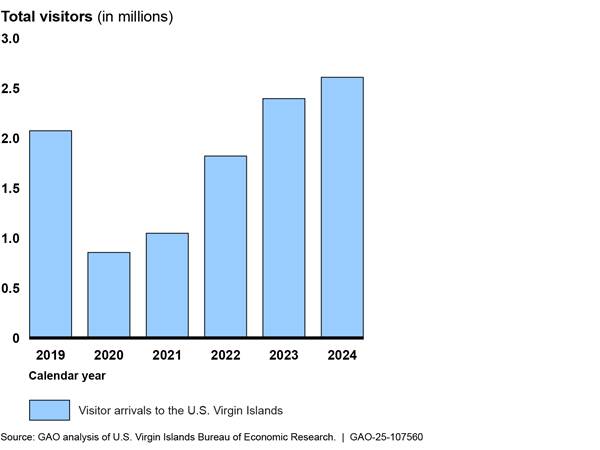
Although the tourism industry is currently doing well, the territory’s
dependence on a single industry poses a risk to its economy. By relying so
heavily on tourism, USVI is vulnerable to events that affect the industry.
Territory officials are working on initiatives to diversify its economy, but doing so remains a challenge. For example, officials said they are working with the Environmental Protection Agency to address issues that led to the closure of the territory’s Limetree Bay oil refinery in 2021. The refinery had been one of the territory’s largest employers, and officials estimated that reopening it would add 1,000 jobs to the territory’s economy.
USVI’s Electric Utility and Other Factors Present Risks
Electric Utility
Electricity in USVI is both expensive and unreliable, which creates challenges for residents and can inhibit economic development. Specifically:
· The cost of electricity is USVI is high, and officials said that metering and billing can be inconsistent. The average price of electricity paid by USVI residents was about 42 cents per kilowatt hour at the end of 2023, almost three times higher than the U.S. national average. Additionally, officials from the territory’s electric and water utility—the Water and Power Authority (WAPA)—said they have had problems with its electricity metering and billing systems that lead to unpredictable costs for consumers and unpredictable revenues for the utility.
· Electric service is not consistent and the territory experiences frequent outages due in part to aging and poorly maintained infrastructure. A January 2025 assessment of WAPA’s current status estimated the cost of the utility’s deferred maintenance to be approximately $33 million.[52] The assessment noted that the delay in proper and timely maintenance is one of the primary contributors to the territory’s rolling blackouts.
WAPA is also liable for a significant amount of debt. As of December 2024, the utility’s debt was approximately $238 million.
A significant contributor to WAPA’s financial problems is electricity rates that are not sufficient to cover its costs. Officials we interviewed said that expenses exceed revenue by about $6 million per month. An unaudited notice of WAPA’s financial status from 2024 acknowledged the utility’s substantial operating deficit, but stated that it is not feasible to raise rates because doing so would likely reduce demand. Additionally, the utility has had issues with unpaid bills belonging to large customers, including components of the territory’s government.[53]
WAPA’s ongoing deficits affect its ability to make critical payments, including to fuel suppliers. Its independent auditor has highlighted growing deficits as a risk to WAPA’s ability to pay its debt, fund pensions and other postemployment benefits, and access capital markets in the future.
WAPA officials told us that the utility has strategic initiatives focused on increasing operational stability and lowering costs that they said aim to prevent default on its debt. Additionally, the January 2025 assessment noted that WAPA management has initiated a debt consolidation process and is working to refinance its debt.
Like the rest of the USVI government, WAPA has been delayed in issuing audited financial statements. Both Fitch and Moody’s withdrew their ratings for WAPA in 2023 due to lack of information.
Climate Risks
USVI is also vulnerable to climate risks, though the territory has plans and projects underway aimed at mitigating these risks. According to the territory’s long-term economic strategy, potential effects of sea level rise include coral reef loss, water shortages, and public health problems.[54]
While the cost of the damage from Hurricanes Irma and Maria in 2017 was close to $11 billion, USVI anticipates receiving about $20 billion in federal funding to aid in rebuilding. Officials told us that the funds will support projects over the next 10 to 15 years to rebuild damaged infrastructure and improve climate resilience, among other things. They said they expect the projects to also have a positive effect on the territory’s economy and revenues.
Population Changes
The territory also continues to face challenges due to its declining population. Between 2010 and 2020, the most recent data available, the territory’s population declined by 18 percent, from about 106,000 to about 87,000. Officials we spoke with cited a lack of economic opportunity as a primary reason for outmigration.
Pension and Other Postemployment Benefits
As stated earlier, pension and other postemployment benefit liabilities represent a fiscal risk. Although the territory’s Government Employees’ Retirement System (GERS) pension system secured additional funding in 2022 through the rum cover-over, an excise tax on rum, it remains one of the lowest-funded public pension plans in the United States. A 2024 actuarial analysis calculated that the pension fund was funded at 11.6 percent as of September 30, 2023.[55] We have previously found that on average public pension plans were about 80 percent funded.[56]
Additionally, the system’s solvency is less certain after the rum cover-over rate declined in 2022 to $10.50 per proof gallon.[57] Prior to that, federal law had raised the rate on a recurring basis to $13.25 per proof gallon. The lower rum cover-over rate generates less funding to contribute to GERS and thus will affect its solvency and its ability to pay debt service costs. Officials estimated that the amount the government received from the rum cover-over in 2024 was about $34 million less than required to fund the pension system, and they expect a higher shortfall in 2025. The government covered shortfalls in fiscal years 2022 and 2023 but did not do so in fiscal year 2024. Officials said they do not plan to cover the shortfall in fiscal year 2025.
According to the fiscal year 2021 financial statements—the most recent available—USVI reported a net pension liability of about $5.7 billion.[58] In addition to a pension, USVI provides other postemployment benefits, such as health care, that represent a large liability. In fiscal year 2021, USVI’s liability for these benefits was about $1.1 billion. Together, these liabilities totaled $6.9 billion and represented 155 percent of GDP in fiscal year 2021.
USVI Continues to Have Substantial Financial Management and Reporting Issues
USVI has had persistent issues with the timeliness of its single audit reports and the reliability of its financial statements. Additionally, independent auditors have consistently identified numerous audit findings related to the territory’s financial reporting and federal awards and a small dollar amount of questioned costs in its federal award programs. As stated previously, timely and reliable financial reporting is important to ensure territories can make informed debt management decisions and access capital markets if needed.
Timeliness. Since fiscal year 2017, USVI has not released its single audit reports on time. As of June 1, 2025, the territory’s fiscal year 2022 reports are 23 months late, and its fiscal year 2023 reports are 11 months late. USVI officials attributed these delays primarily to a shortage of qualified financial professionals and their inability to obtain timely financial information from the territory’s component units, which the government includes in its government-wide financial statements. Without current audited financial statements, the territory will struggle to reestablish a credit rating and access capital markets.
· Audit opinions. The territory has consistently received modified audit opinions on its financial statements and major federal award programs. In fiscal year 2021, USVI received a qualified opinion on its governmental activities and a disclaimer of opinion on its business-type activities for, in part, not maintaining the necessary documentation to support various account balances and financial activities.[59] USVI also received a disclaimer of opinion on its component units for, in part, omitting component unit financial information or including unaudited or unsupported component unit financial information. Additionally, USVI received a qualified or adverse opinion on over half of its major federal award programs, meaning auditors found compliance issues that had a direct and material effect on those programs.
· Audit findings. USVI’s independent auditors have identified a number of serious audit findings that have remained unresolved for several years. For example, the auditors identified recurring material weaknesses related to USVI’s periodic and fiscal year-end financial close process and accounting for tax revenue and receivables.[60] Such internal control weaknesses have delayed the preparation of year-end financial statements and increased the risks of inaccurate reporting, impaired financial decision-making, and fraudulent activity. Additionally, auditors found that all of USVI’s major federal award programs had at least one instance of noncompliance, primarily because controls to ensure compliance did not appear to be in place.
· Questioned costs. Auditors have consistently been unable to determine whether there are any questioned costs for the majority of USVI’s federal award findings. For example, in fiscal year 2021, USVI had total questioned costs of $33,000, despite having a large number of reported findings that year.[61]
These findings are important for of the following reasons:
· Timely and reliable financial data provide important information for investors, policymakers, oversight bodies, and the public on the financial and economic condition of the territory.
· Robust internal controls are important to support managers as they make financial decisions or adapt to shifting environments, evolving demands, changing risks, and new priorities as they arise.
· Strong controls over compliance help ensure federal award programs meet objectives and are compliant with applicable laws and regulations. Furthermore, they reduce the risk that territories will have to return disallowed costs or be excluded from future federal funding due to noncompliance with federal award program requirements.
As previously mentioned, USVI has had considerable staffing challenges. USVI officials explained that the territory lost many skilled workers following the hurricanes in 2017, and the government has struggled to retain those who remain. To address this issue and improve the reliability and timeliness of USVI’s financial reporting, the territory continues to offer a fellowship program designed to attract and train new accounting staff.
Commonwealth of the Northern Mariana Islands (CNMI)
CNMI Faces Significant Challenges Meeting Financial Obligations and Incurred More Debt to Cover Pension Contributions
CNMI Incurred More Debt to Cover Pension Contributions
CNMI has struggled to finance its pensions. In 2013, a U.S. district court approved a settlement agreement with the territory’s government pension plan, which applied for bankruptcy in 2012. As part of the settlement, CNMI agreed to make minimum annual contributions to the fund to allow members to receive 75 percent of their full benefits.[62]
CNMI obtained a loan to pay its required pension contribution for fiscal year 2020 and, more recently, obtained a second, larger loan to pay the first loan as well as the required pension contribution for fiscal year 2025. As we reported in 2023, the CNMI government obtained a $24.3 million loan from the Bank of Guam in 2020 to make the required pension contribution for that year. In November 2024, CNMI obtained a second $51 million loan from the Bank of Guam to cover its minimum mandatory pension contribution for fiscal year 2025 and retire the remaining balance of its 2020 loan obligation. Officials stated that the CNMI government has pledged its business gross revenue tax for the payment of obligations on the 2024 loan. The new loan has a repayment term of 10 years at 8 percent interest.
CNMI officials told us they are working to reestablish access to capital markets and seek to issue bonds to cover the government’s minimum pension contribution for fiscal year 2026. Officials said that while they are trying to issue bonds by September 2025, issuance in January 2026 is more likely because CNMI does not have an active credit rating and first needs to issue its fiscal year 2022 and 2023 audited financial statements.[63] Moody’s withdrew its Ba3 credit rating for the government of CNMI in April 2020, and as of April 2025, the CNMI government does not have an active credit rating.[64]
Public Debt
|
Reliability of the Commonwealth of the Northern Mariana Islands’ Financial Information Independent auditors have consistently identified issues that raise concerns about the reliability of the Commonwealth of the Northern Mariana Islands’ (CNMI) financial statements. For example, CNMI has struggled to obtain clean audit opinions. We present CNMI’s financial statement information from fiscal years 2019 through 2021 because it is the most recent comprehensive data available on the territory’s financial status as of June 1, 2025. However, given the material and pervasive nature of the issues identified, the public debt, revenue, expense, and net pension liability data included in our report could be significantly misstated. Source: GAO analysis of the CNMI’s audited financial statements. | GAO‑25‑107560 |
CNMI’s total public debt outstanding was $121.1 million, about 13 percent of GDP in fiscal year 2021, according to our analysis of CNMI’s most recent available financial statement. This reflects an increase of 12 percent from $108.5 million in 2019.[65] The primary government is responsible for most of the territory’s public debt. Of the components, only the Commonwealth Ports Authority and Public School System had debt outstanding as of fiscal year 2021. Figure 22 shows the composition of CNMI’s total public debt as of September 30, 2021.
Figure 22: Composition of Commonwealth of the Northern Mariana Islands’ Public Debt Outstanding, as of September 30, 2021
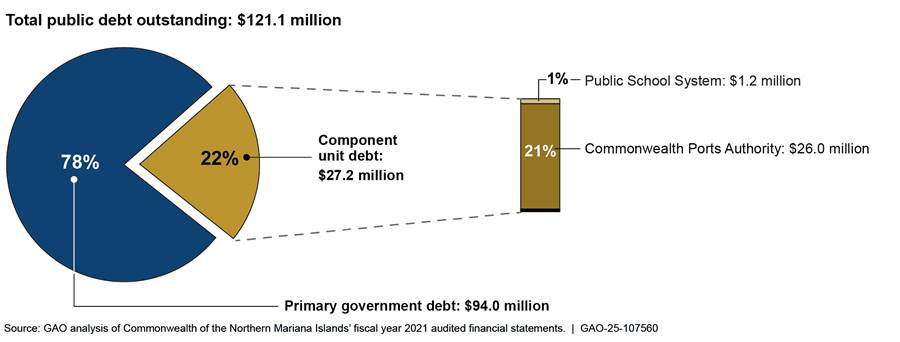
Notes: Our calculation of public debt outstanding includes the sum of bonds and other debt payable, which may be marketable notes issued by territorial governments, nonmarketable intragovernmental notes, notes and loans held by local banks, and federal and intragovernmental loans. Fiscal year 2021 is the most recent year for which audited financial data are available.
CNMI Reported Deficits in Fiscal Years 2019 and 2021
CNMI officials told us that the territory’s fiscal condition is very dire. Figure 23 shows CNMI’s primary government and component unit surpluses and deficits in fiscal years 2019 through 2023.
Figure 23: Commonwealth of the Northern Mariana Islands’ Surpluses and Deficits in Fiscal Years (FY) 2019 to 2023
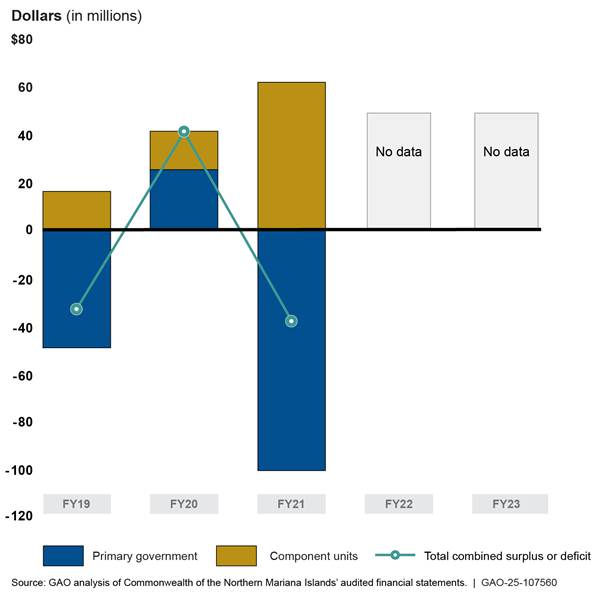
Note: FY 2021 is the most recent year for which audited
financial data are available.
According to the fiscal year 2021 audited financial statement—the most recent available—CNMI had a deficit of $38.8 million that year, a reversal of the $40.4 million surplus in fiscal year 2020. In fiscal year 2019, CNMI had a deficit of $33.3 million.
· The primary government had a $100.1 million deficit, a $51.3 million deficit increase from the $48.9 million deficit in fiscal year 2019 (numbers do not add due to rounding). When comparing fiscal year 2021 to fiscal year 2019, increases in expenses outpaced increases in revenue.
· The component units’ surplus of $61.3 million is $45.8 million larger than the surplus from fiscal year 2019, as increases in revenues outpaced increases in expenses.
Revenues
CNMI’s total revenue in fiscal year 2021 was almost $1.1 billion, an increase of about 60 percent from fiscal year 2019.
· CNMI’s primary government revenue was $747.6 million, an increase of 57 percent from fiscal year 2019. Officials told us that the increases in revenue were primarily due to higher levels of federal grant funding received, which they told us comprised 74 percent of primary government revenue in fiscal year 2021. Federal financial assistance related to COVID-19 and disaster response funded a wide range of public assistance programs within CNMI, according to officials.
· The component units recorded $302.7 million in revenue, an increase of 67 percent from fiscal year 2019. The component unit that reported the largest revenue increase from fiscal years 2019 to 2021 was the Commonwealth Utilities Corporation.
Figure 24 shows CNMI’s total, primary government, and component unit revenues from fiscal years 2019 through 2023.
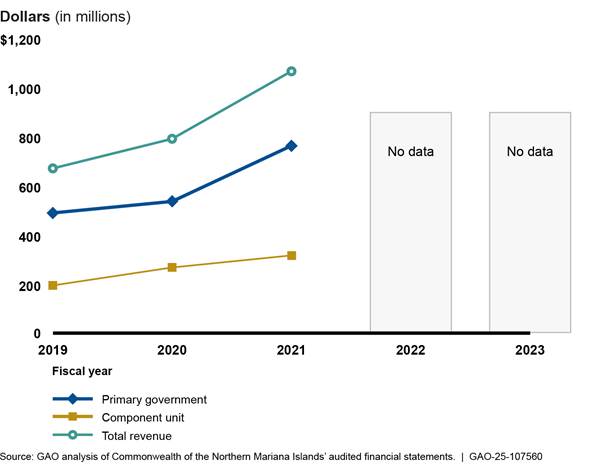
Note: Fiscal year 2021 is the most recent year for which audited financial data are available.
Expenses
CNMI’s total expenses in fiscal year 2021 were $1.1 billion, a 58 percent increase from fiscal year 2019.
· The primary government expenses were $847.8 million, a 62 percent increase from fiscal year 2019. According to our analysis of CNMI’s financial statements, these increases were largely due to increases in spending in economic development and public welfare.
· The component units’ expenses were $241.3 million, a 46 percent increase from fiscal year 2019. The component unit that reported the largest expense increase from fiscal year 2019 to 2021 was the Commonwealth Utilities Corporation.
Figure 25 shows CNMI’s total, primary government, and component unit expenses from fiscal years 2019 through 2023.
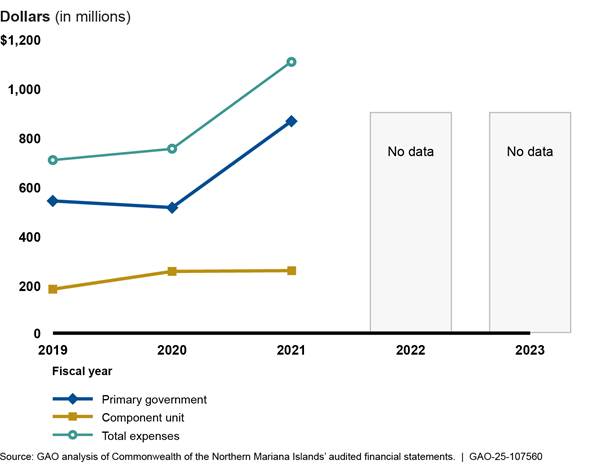
Note: Fiscal year 2021 is the most recent year for which audited financial data are available.
CNMI’s Economy Is Declining and the Territory Faces Significant Fiscal Risks
Most Recent GDP Trends Have Been Volatile
With the tourism industry struggling to recover, federal assistance slowing or expiring, and weak financial management practices persisting, CNMI is at risk of a severe fiscal crisis. CNMI’s GDP was about $1 billion in fiscal year 2022. Adjusted for inflation, this represented economic growth of around 14 percent from the previous year.[66] However, its real GDP decreased an average of about 8 percent in fiscal years 2018 through 2022 after its real GDP experienced an average increase of around 11 percent from fiscal years 2013 through 2017 (see fig. 26). As stated previously, the strength of a territory’s economy affects its ability to repay debt and access capital markets.
Figure 26: Commonwealth of the Northern Mariana Islands’ Real Gross Domestic Product in Fiscal Years 2013 Through 2022 (in 2012 dollars)
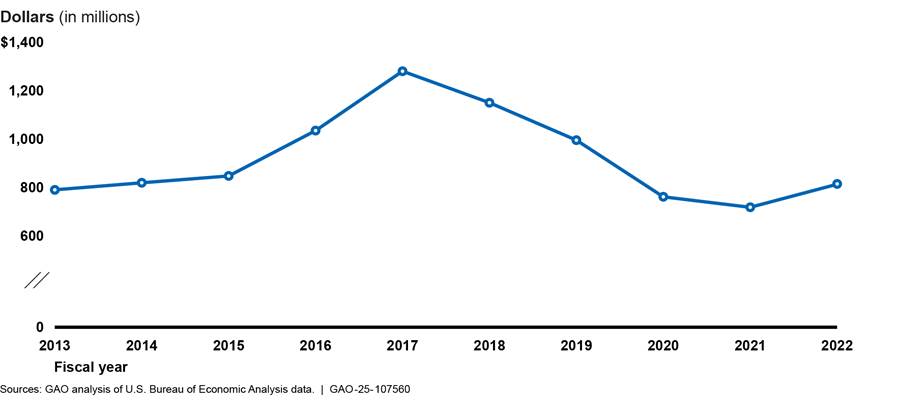
Note: Fiscal year 2022 is the most recent year for which data are available.
Decline in Tourism and Other Factors Present Fiscal Risks
Tourism
CNMI’s economy remains heavily dependent on tourism, which has not significantly recovered after a steep drop during the COVID-19 pandemic. Visitors in 2024 increased to 228,963 from a 2021 low of 12,684 but remain well below pre-pandemic levels, which were nearly 500,000 in 2019. Officials told us they need at least 500,000 visitors to CNMI each year for economic stability and to avoid future hotel closures. Figure 27 shows the number of visitors to CNMI for calendar years 2019 through 2024.
Figure 27: Number of Visitors to the Commonwealth of the Northern Mariana Islands in Calendar Years 2019 Through 2024
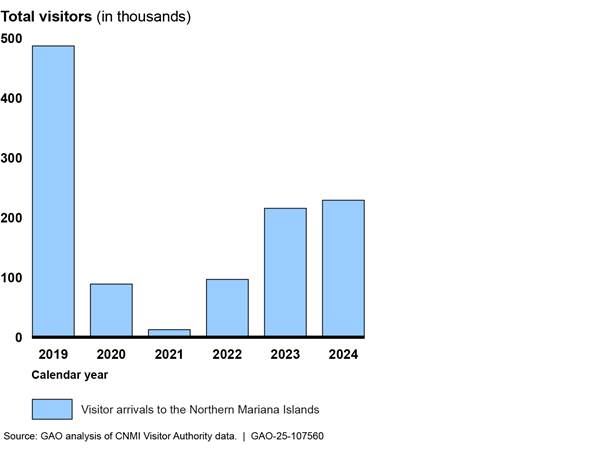
About 73 percent of visitors to CNMI arrived from South Korea in 2024. In 2019,
tourism from mainland China represented 38 percent of visitors; however, this
number decreased to 8 percent in 2024 and there are currently no direct flights
from mainland China to CNMI. Additionally, according to officials, a lack of
competition among airlines flying between CNMI and Guam has led to higher
ticket prices. Officials stated that it would be desirable to open inter-island
flights to foreign carriers to achieve affordable airline service in CNMI, but
cabotage laws (which prohibit foreign carriers from operating routes between
two locations within the United States) do not allow for this.
The economic impact of tourism losses has been exacerbated by the closure of the Imperial Pacific Casino in March 2020 after 3 years of operation and the July 2024 closure of the Hyatt Regency Saipan. During our August 2024 fieldwork in CNMI, we observed numerous closed businesses in a central district near the Hyatt (see fig. 28). According to officials, decreased revenue led to the Hyatt’s closure. Officials stated that the recent closure of the Hyatt is likely to have negative spillover effects on the island’s economy. As of March 2025, the Hyatt has reopened as the Marianas Beach Resort and is expected to fully transition to a Sheraton hotel by the end of the year.
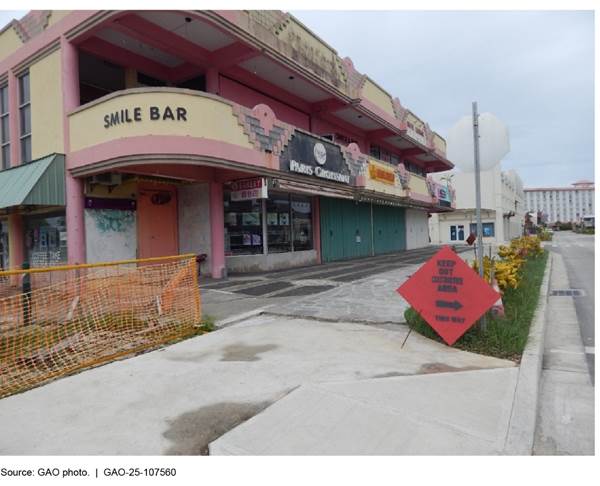
Workforce Limitations
Officials reported limited success of workforce training efforts that could help diversify the CNMI economy through new industries such as construction and information technology. According to officials from the CNMI Department of Labor, the government has implemented internship programs with local businesses, but graduates of the program often receive offers for full-time positions off island that pay higher wages.
Officials described outmigration and a shrinking skilled workforce as immediate challenges to CNMI’s economic recovery. Officials told us that efforts to diversify the economy through military investment have been impeded by the lack of available skilled local workers.[67] CNMI officials emphasized the importance of extending the CNMI-Only Transitional Worker program due to CNMI’s continued reliance on foreign workers.[68]
Pension Liabilities
As stated earlier, pension liabilities represent a fiscal risk. CNMI reported a net pension liability of $440.8 million, about 49 percent of GDP, as of September 30, 2021. CNMI’s net pension liability decreased by 17 percent from fiscal year 2019 to fiscal year 2021. However, independent auditors determined in fiscal year 2021 that CNMI did not properly follow pension accounting standards, which greatly reduces the reliability of this information.[69] Officials cited minimum annual contributions to the pension settlement fund, strong investment performance of the fund, and a reduction in the beneficiary population due to mortality as reasons for the reduction in pension liability in fiscal year 2021. CNMI also offers other postemployment benefits but does not report a liability related to these benefits on its government-wide financial statements.
CNMI Continues to Have Substantial Financial Management and Reporting Issues
CNMI has serious and long-standing issues with the timeliness of its single audit reports and the reliability of its financial statements. Additionally, independent auditors continue to identify a number of serious audit findings and a substantial dollar amount of questioned costs associated with its federal award programs. As stated previously, timely and reliable financial reporting is important to ensure territories can make informed debt management decisions and access capital markets if needed.
Timeliness. CNMI’s single audit reports have been increasingly delayed since fiscal year 2018. CNMI’s most recently available reports, for fiscal year 2021, were issued more than 25 months late. As of June 1, 2025, the territory’s fiscal year 2022 reports are 23 months late, and its fiscal year 2023 reports are 11 months late. CNMI officials stated that the ongoing transition to a new financial management system, change in independent auditors, and the effect of the COVID-19 pandemic were the primary reasons for the delays. CNMI officials also noted that they foresee persistent challenges affecting their ability to issue timely financial statements in the future, specifically related to recruiting qualified staff and funding financial management system upgrades. Without current audited financial statements, the territory will struggle to reestablish a credit rating and access capital markets. Further, officials from the Office of Insular Affairs have stated that they are closely monitoring the completion date of CNMI’s fiscal year 2022 and 2023 single audits. In the past, this office has warned CNMI that single audit delays could affect the territory’s eligibility for federal grant assistance.
Audit opinions. The territory has long-standing issues with following pension reporting requirements and omitting component unit data from its government-wide financial statements. These problems have led its auditors to issue adverse or disclaimer of opinions on CNMI’s governmental activities and component units every fiscal year since at least 2017.[70] In fiscal years 2020 and 2021, CNMI also received a disclaimer of opinion on its governmental activities because it was unable to provide sufficient appropriate audit evidence to support a substantial number of the primary government’s account balances and financial activities due to inadequacies in its accounting records. Additionally, in fiscal year 2021, CNMI received a qualified opinion on 12 of its 14 major federal award programs, meaning auditors found compliance issues that had a direct and material effect on most of those programs.
Audit findings. CNMI’s auditors have identified a number of serious audit findings that have remained unresolved for several years. In fiscal year 2021, among other reported issues, auditors identified material weaknesses in financial reporting and compliance controls related to the financial close process, reconciliations, cash management, procurement, physical inventory, recordkeeping, and monitoring. These deficiencies have resulted in CNMI’s noncompliance with a number of federal award program requirements and substantially increase the risks of delayed and inaccurate financial reporting, impaired financial decision-making, and fraudulent activity.
Questioned costs. CNMI’s reported total questioned costs associated with its federal award audit findings were $52 million in fiscal year 2021, which is 10 percent of the territory’s total federal award expenditures in that year.[71] Including the fiscal year 2021 questioned costs, the territory’s reported cumulative questioned costs that remained unresolved were $104.3 million as of September 30, 2021. As previously discussed, this territory is facing significant financial challenges. If these questioned costs are disallowed, this will cause further financial strain for the territory as it will need to return a substantial amount of funding to the federal government.
These findings are important for the following reasons:
· Timely and reliable financial data provide important information for investors, policymakers, oversight bodies, and the public on the financial and economic condition of the territory.
· Robust internal controls are important to support managers as they make financial decisions or adapt to shifting environments, evolving demands, changing risks, and new priorities as they arise.
· Strong controls over compliance help ensure federal award programs meet objectives and are compliant with applicable laws and regulations. Furthermore, they reduce the risk that territories will have to return disallowed costs or be excluded from future federal funding due to noncompliance with federal award program requirements.
As previously mentioned, CNMI is transitioning to a new financial management system. The new system has helped the territory to streamline financial management functions and reduce its reliance on manual processes. However, independent auditors do not anticipate any improvements to CNMI’s internal control findings or audit opinions until the release of the 2024 audit at the earliest, when the new financial management system’s implementation will be reflected in CNMI’s financial statements.
American Samoa
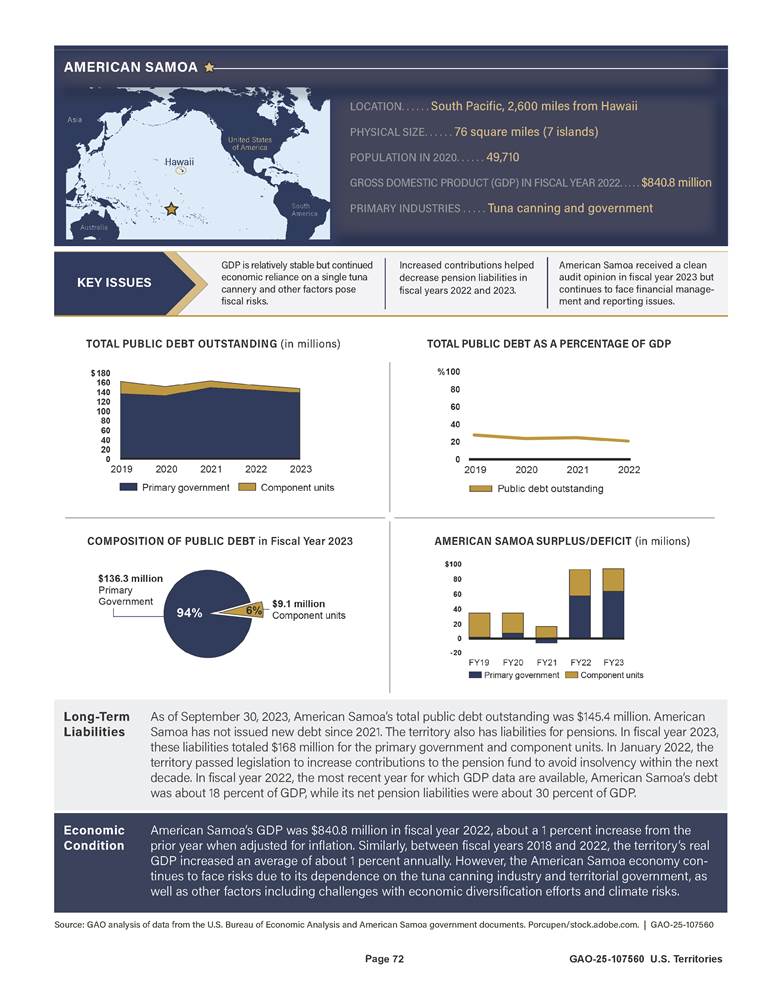
American Samoa Has Not Issued New Debt Since 2021
American Samoa officials said they have not issued general revenue bonds since June 2021. Part of the proceeds from the 2021 bonds financed the acquisition and construction of a new legislature and high court buildings (see fig. 29). Territory officials said they may refund some of the government’s 2015 bonds in 2025 to reduce debt service cost through a lower interest rate.
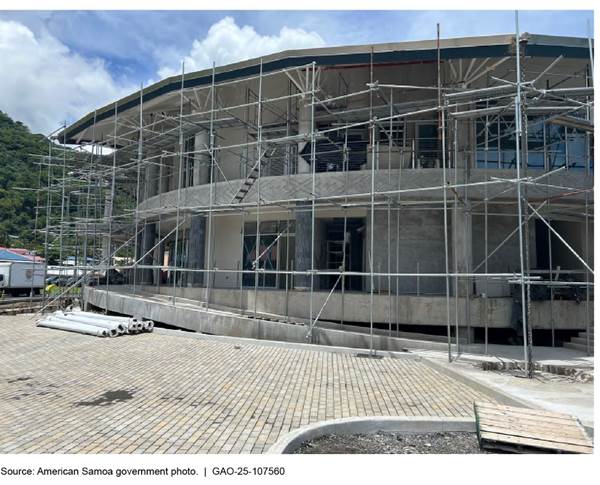
As of April 2025, Moody has maintained its stable credit outlook and Ba3 credit rating for the government of American Samoa. The Ba3 rating means that bonds issued by American Samoa are considered non-investment grade and subject to substantial credit risk. According to Moody’s November 2024 report, the rating takes into consideration the territory’s small and volatile economy, the concentration of employment in government and tuna packing, very low resident income levels, above-average long-term liabilities, and risks associated with operating a government-owned charter bank. The rating also reflects the significance of the risk of sea-level rise.
Based on our analysis of American Samoa’s fiscal year 2023 audited financial statements, total public debt outstanding was $145.4 million, a 10 percent decrease from fiscal year 2021.[72] Figure 30 shows the shares of the debt outstanding from the primary government and component units.
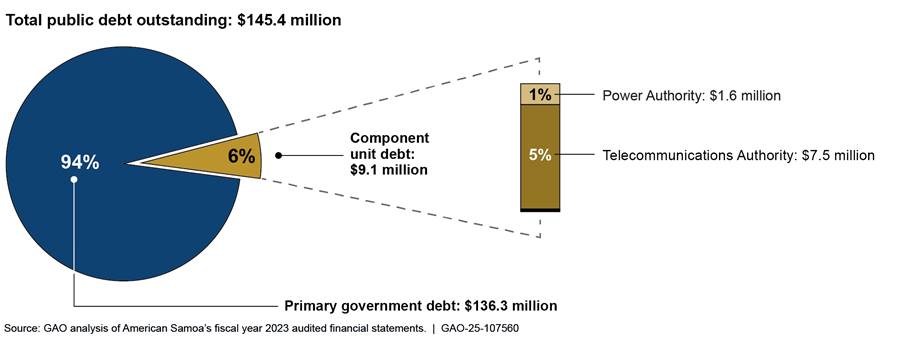
Notes: Our calculation of public debt outstanding includes
the sum of bonds and other debt payable, which may be marketable notes issued
by territorial governments, nonmarketable intragovernmental notes, notes and
loans held by local banks, and federal and intragovernmental loans. Fiscal year
2023 is the most recent year for which audited financial data are available.
American Samoa’s Reported Surpluses Grew in Fiscal Years 2022 and 2023
American Samoa maintained an overall surplus in fiscal years 2019 through 2023 and reported the highest surpluses in fiscal years 2022 and 2023, as shown in figure 31.
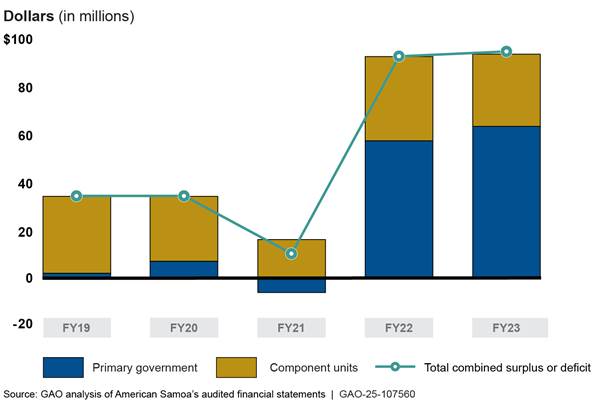
Note: FY 2023 is the most recent year for which audited
financial data are available.
In fiscal year 2023, American Samoa had an overall surplus of $93.7 million, an $84.2 million increase from fiscal year 2021.
· The primary government had a $63.4 million surplus, a $69.3 million reversal from the $6 million deficit in fiscal year 2021, as increases in revenue outpaced increases in expenses.
· The component units’ surplus of $30.3 million is $14.8 million larger than the surplus from fiscal year 2021, as increases in revenue outpaced increases in expenses.
Revenues
In fiscal year 2023, American Samoa’s total revenue was about $855.7 million, an increase of about 43 percent from fiscal year 2021.
· In fiscal year 2023, American Samoa’s primary government revenue was approximately $607.5 million, an increase of around 52 percent from fiscal year 2021. The largest increase in revenue from fiscal years 2021 to 2023 came from grants and contributions for education and culture programs. Territory officials said that revenues increased because of increased corporate tax revenues and COVID-19 related federal stimulus funds.
· American Samoa’s component units recorded total revenues of $248.3 million, an increase of 26 percent from fiscal year 2021. The component unit that reported the largest revenue increase from fiscal year 2021 to 2023 was the American Samoa Power Authority. American Samoa officials said this was largely due to higher prices of fuel used to generate electricity, which were passed on to customers in the form of service charges. Overall, increases in service charge revenue at the Power Authority slightly outpaced increases in total expenses.
Figure 32 shows American Samoa’s total revenues, primary government revenues, and component unit revenues in fiscal years 2019 through 2023.
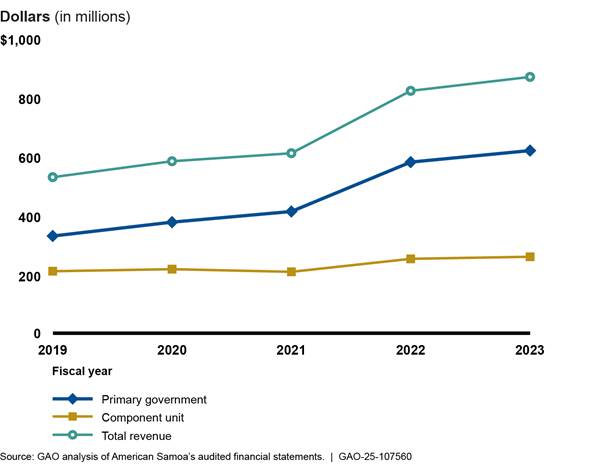
Note: Fiscal year 2023 is the most recent year for which
audited financial data are available.
Expenses
In fiscal year 2023, American Samoa’s total expenses were $762 million, a 30 percent increase from fiscal year 2021.
· In fiscal year 2023, American Samoa’s primary government expenses were $544.1 million, an increase of around 34 percent from fiscal year 2021. Reflecting the increase in grants and contributions discussed above, the largest rise in primary government expenses from 2021 and 2023 was in education and culture programs.
· American Samoa’s component units recorded total expenses of $217.9 million, an increase of approximately 20 percent from fiscal year 2021.The Power Authority reported the largest increase in expenses of any component unit from fiscal year 2021 to 2023. As described above, officials stated that this was due to the higher cost of fuel used to generate electricity.
Figure 33 shows American Samoa’s total expenses, primary government expenses, and component unit expenses in fiscal years 2019 through 2023.
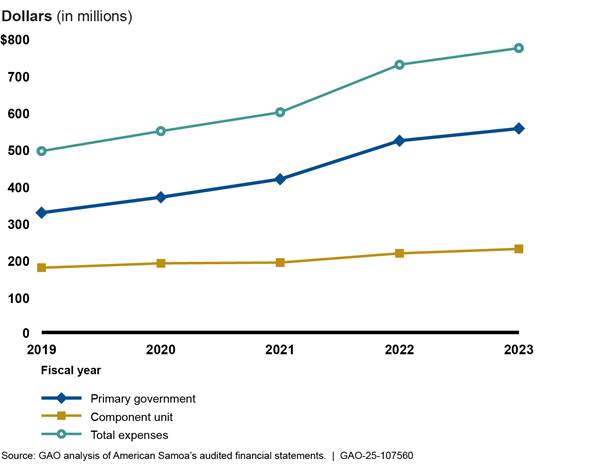
Note: Fiscal year 2023 is the most recent year for which audited financial data are available.
American Samoa Continues to Rely on a Single Tuna Cannery and Faces Other Fiscal Risk Factors
Most Recent Data Show Stable GDP
American Samoa’s GDP is relatively stable, totaling $840.8 million in fiscal year 2022.[73] Adjusted for inflation, this represented economic growth of around 1 percent from the previous year. Similarly, its real GDP decreased an average of about 1 percent annually in fiscal years 2013 through 2017 before increasing an average of about 1 percent annually in fiscal years 2018 through 2022 (see fig. 34). As stated previously, the strength of a territory’s economy affects its ability to repay debt and access capital markets.
Figure 34: American Samoa’s Real Gross Domestic Product in Fiscal Years 2013 Through 2022 (in 2012 dollars)

Note: Fiscal year 2022 is the most recent year for which data are available.
Lack of Economic Diversification and Other Factors Present Risks
While American Samoa’s GDP has been relatively stable, its economy continues to face fiscal risks due to its dependence on the territorial government and tuna canning industry, as well as other factors, including challenges with economic diversification efforts and climate risks.
Reliance on a Single Tuna Cannery
As we have previously reported, the StarKist Samoa cannery—the sole tuna cannery remaining in the territory—faces challenges.[74] Both territory and StarKist officials cited the importance of a federal tax credit to the tuna industry and the degree to which the credit’s temporary nature contributes to economic uncertainty.[75] StarKist officials also mentioned challenges with meeting the territory’s minimum wage increases.
According to the U.S. Bureau of Economic Analysis, fish exports from American Samoa declined 29 percent in 2021 compared to 2020. More recently, the U.S. Bureau of Economic Analysis reported that fish exports increased 3 percent in 2022 when compared to 2021. In April 2025, an executive order lifted restrictions that previously prohibited commercial fishing to conserve marine species and ecosystems in a protected area near American Samoa. In a statement released in response to this change, the governor of American Samoa said that the reopening of commercial fishing will help maintain the tuna cannery’s operations and competitiveness.
We reported in June 2020 that the government was investing in developing a call center industry to diversify the territory’s economy.[76] As of March 2025, territory officials told us they are in the design phase of the call center’s building and have identified a location and the company that will construct the building. Territory officials added that the cost of broadband internet and electricity are barriers for businesses in American Samoa. To address the cost of broadband and improve overall economic development, American Samoa officials have developed a broadband strategy and identified priorities and actions to increase broadband across the territory. According to officials, they are enhancing high-speed broadband infrastructure to continue developing the territory’s technology sector.
Tourism
American Samoa is located in a remote part of the South Pacific Ocean, which reduces the viability of developing a robust tourism industry. Territory officials said that they are in discussions with airlines to increase the number of flights to the territory. They also noted an increase in the number of cruise ships traveling to the territory.
Climate Risks
We previously reported that American Samoa is vulnerable to tsunamis and other coastal hazards.[77] According to the U.S. Geological Survey, the territory is vulnerable to sea-level rise partly because of the steep terrain of its islands. Further, the agency reported that the territory’s islands are sinking because of the 2009 earthquakes. These events can directly affect the economy by, for example, damaging property and infrastructure and displacing individuals.
To address these risks, territory officials said they developed a resilience commission office and joined the Pacific Islands Forum.[78] As new members of the Pacific Islands Forum, territory officials believe that they can learn best practices from other islands and coordinate to mitigate climate risks across the region.
Pension Liabilities
As stated earlier, pension liabilities represent a fiscal risk. American Samoa’s pension liabilities decreased from fiscal year 2021 to 2023. In fiscal year 2021, American Samoa’s primary government and component units reported having almost $262 million in net pension liabilities—about 35 percent of GDP. In January 2022, American Samoa passed legislation to increase contributions to the pension fund to avoid insolvency within the next decade.[79] As of September 30, 2023, American Samoa’s primary government and component units reported having over $168 million in net pension liabilities, a decrease of 32 percent from fiscal year 2022 and a decrease of 36 percent from fiscal year 2021.[80] Officials attributed these decreases to a high return on investment for the territory’s pension plans and to increased contributions.
American Samoa’s Financial Statements Are Timely and Reliable but Some Weaknesses in Internal Control Exist
American Samoa has submitted its single audit reports on time in recent years. In fiscal year 2023, the territory received a clean financial statement audit opinion and did not have any reported questioned costs associated with its federal award programs. However, independent auditors have identified recurring audit findings, as described below. As stated previously, timely and reliable financial reporting is important to ensure territories can make informed debt management decisions and access capital markets if needed.
Timeliness. American Samoa has submitted its yearly single audit reports on time since at least 2017.
Audit opinions. The audit opinion on the territory’s financial statements has recently improved. The territory received an unmodified (clean) audit opinion on its most recent fiscal year 2023 financial statement, after several years of receiving qualified opinions.[81] Additionally, American Samoa received a clean opinion on each of its major federal award programs, meaning auditors did not find any compliance issues that had a direct and material effect on those programs.
Audit findings. The territory’s independent auditors have identified a recurring material weakness in internal control over financial reporting related to its financial close and reporting process.[82] This weakness reduced the government’s ability to produce timely and reliable financial reports on a monthly, quarterly, and annual basis without significant adjustments after the books were closed. Auditors have also reported that the territory has not established required quality control procedures for one of its federal award programs. As a result, American Samoa does not have any monitoring controls in place to ensure compliance with the federal award program’s requirements.
Questioned costs. American Samoa’s auditors did not identify any questioned costs in fiscal year 2023.[83]
These findings are important for the following reasons:
· Timely and reliable financial data provide important information for investors, policymakers, oversight bodies, and the public on the financial and economic condition of the territory.
· Robust internal controls are important to support managers as they make financial decisions or adapt to shifting environments, evolving demands, changing risks, and new priorities as they arise.
· Strong controls over compliance help ensure federal award programs meet objectives and are compliant with applicable laws and regulations. Furthermore, they reduce the risk that territories will have to return disallowed costs or be excluded from future federal funding due to noncompliance with federal award program requirements.
Agency Comments, Third-Party Views, and Our Evaluation
We provided a draft of this report for review and comment to the Department of the Interior and the governments of the Commonwealth of Puerto Rico, Guam, the U.S. Virgin Islands, the Commonwealth of the Northern Mariana Islands, and American Samoa. The Department of the Interior and the governments of Puerto Rico, the U.S. Virgin Islands, and American Samoa provided technical comments, which we incorporated as appropriate. The governments of Puerto Rico, Guam, the U.S. Virgin Islands, and American Samoa provided written comments that are reprinted in appendixes I, II, III, and IV respectively, and summarized below. We did not receive comments from the government of the Commonwealth of the Northern Mariana Islands.
The letter from the government of Puerto Rico confirmed receipt of the draft and clarified that its review was limited to content related to Puerto Rico.
The letter from the government of Guam noted the territory’s commitment to fiscal discipline, highlighting recent refinancing of debt, increased tax collections, and new capital projects, among other things. The letter also highlighted the territory’s economic recovery since the COVID-19 pandemic and new economic initiatives of the government.
The letter from the government of the U.S. Virgin Islands provided additional information about the territory’s recently issued debt, which we incorporated into the report as appropriate. In the letter, the government also inquired about our methodology for calculating deficits, surpluses, revenues, and expenses, noting that it uses a different calculation. Consistent with prior iterations of this report, we do not include one-time special items in these calculations. We believe this method gives a clearer presentation of each territory’s long-term fiscal sustainability. We have included more detailed information about what is included in our calculations in the relevant figure notes.
The letter from the government of American Samoa provided additional context about the territory’s population, economy, finances, and natural risks. The letter raised concerns about the population data we reported from the decennial census. The Census Bureau uses the same methodology for American Samoa as it does for all of the territories included in the decennial Island Areas Census and thus we use its data to describe population trends in American Samoa and the other territories.
We are sending copies of this report to the appropriate congressional committees, to the Governor of each territory, and to the Secretary of the Interior. In addition, the report will be available at no charge on the GAO website at http://www.gao.gov.
If you or your staffs have questions about this report, please contact Yvonne D. Jones at JonesY@gao.gov or Latesha Love-Grayer at LoveGrayerL@gao.gov.
GAO staff who made key contributions to this report are listed in appendix V.

Yvonne D. Jones
Director, Strategic Issues
Latesha Love-Grayer
Director, International Affairs and Trade
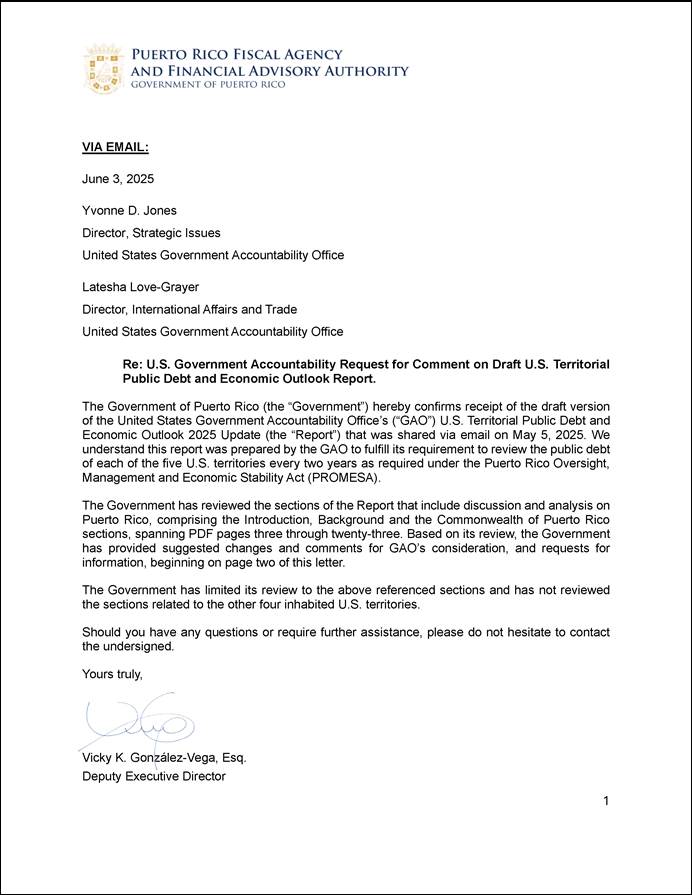

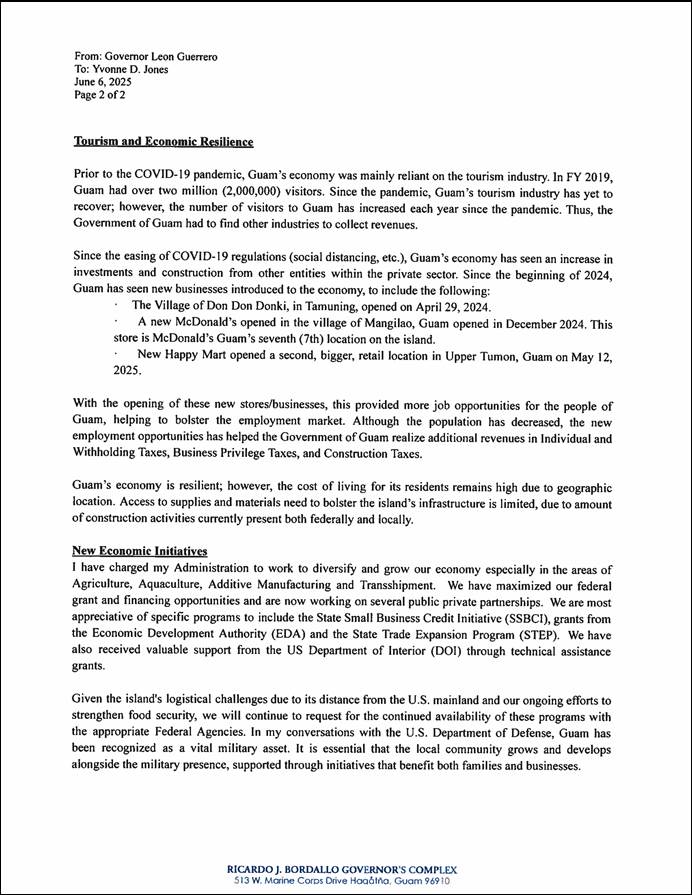
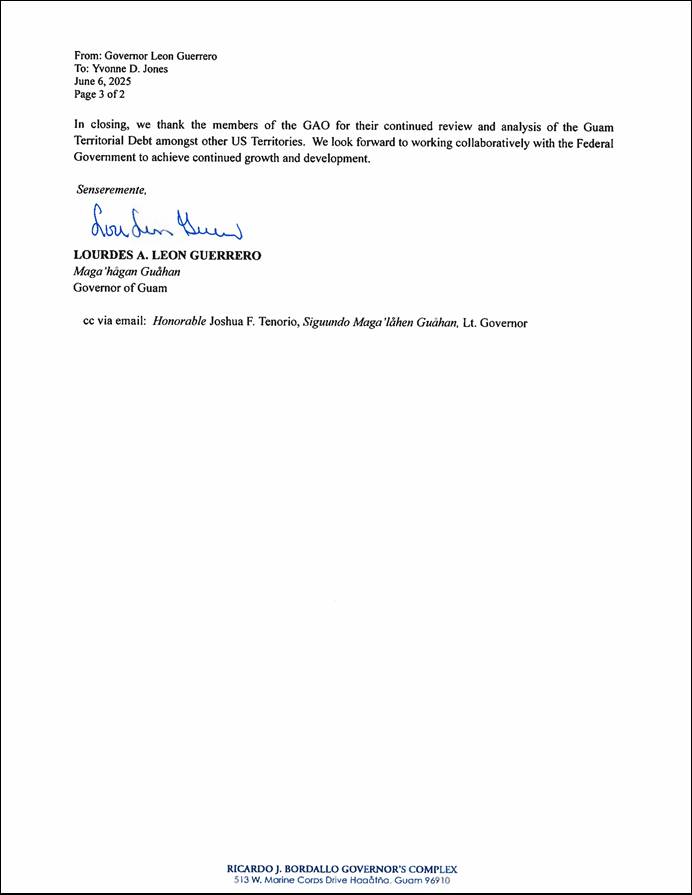
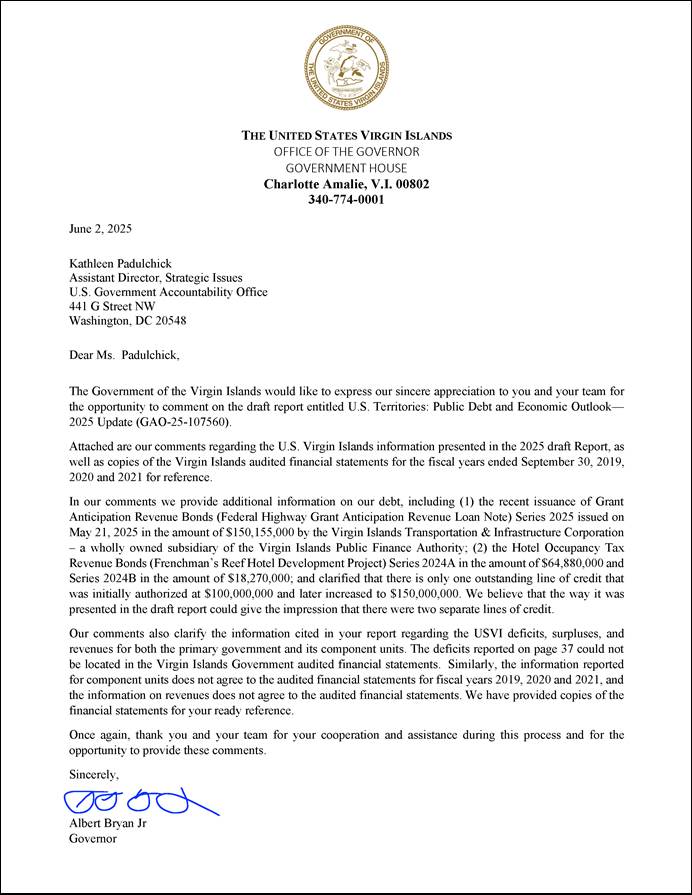
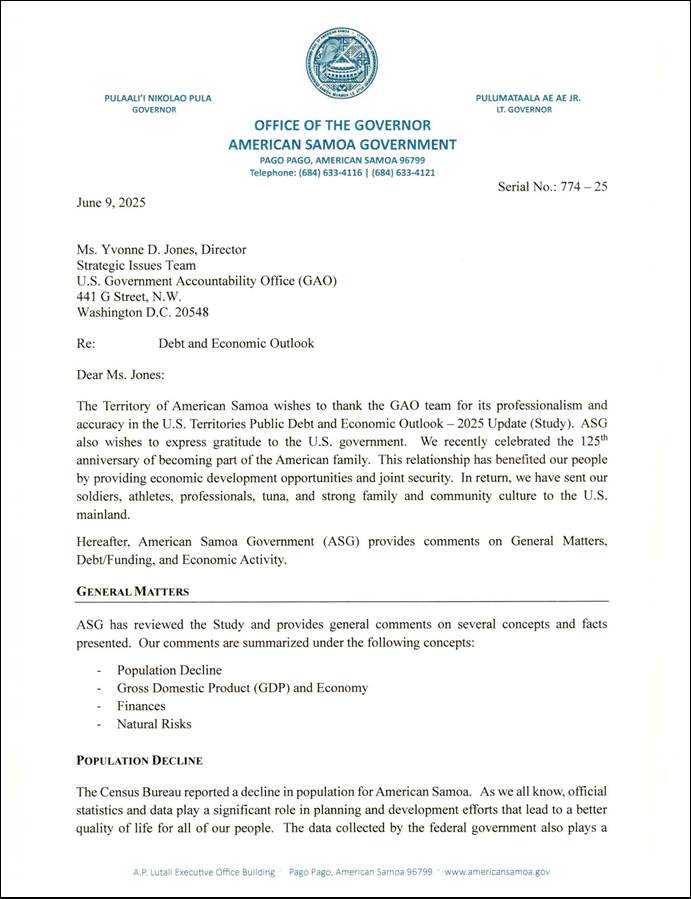
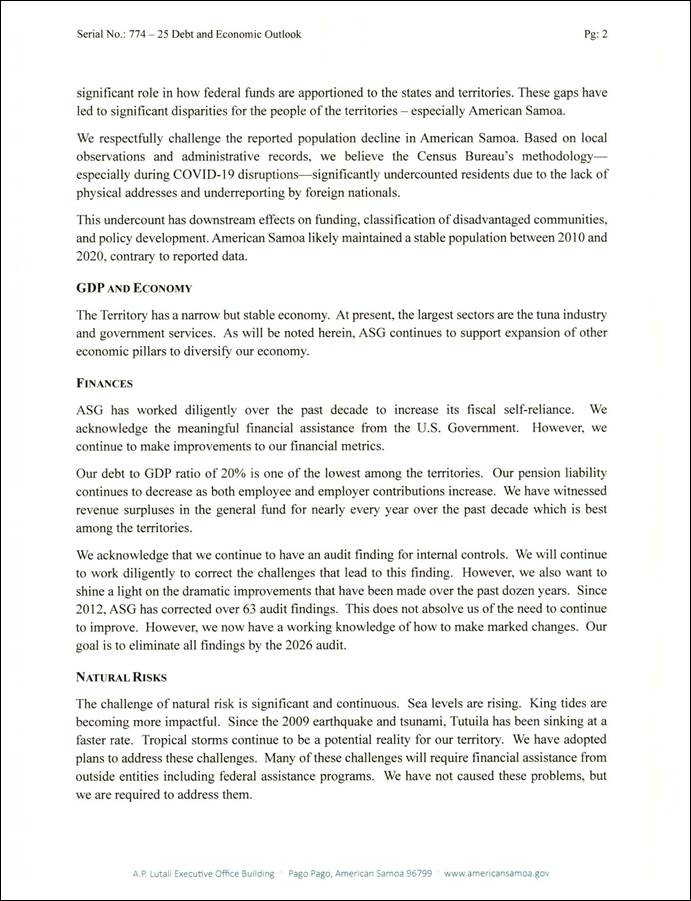
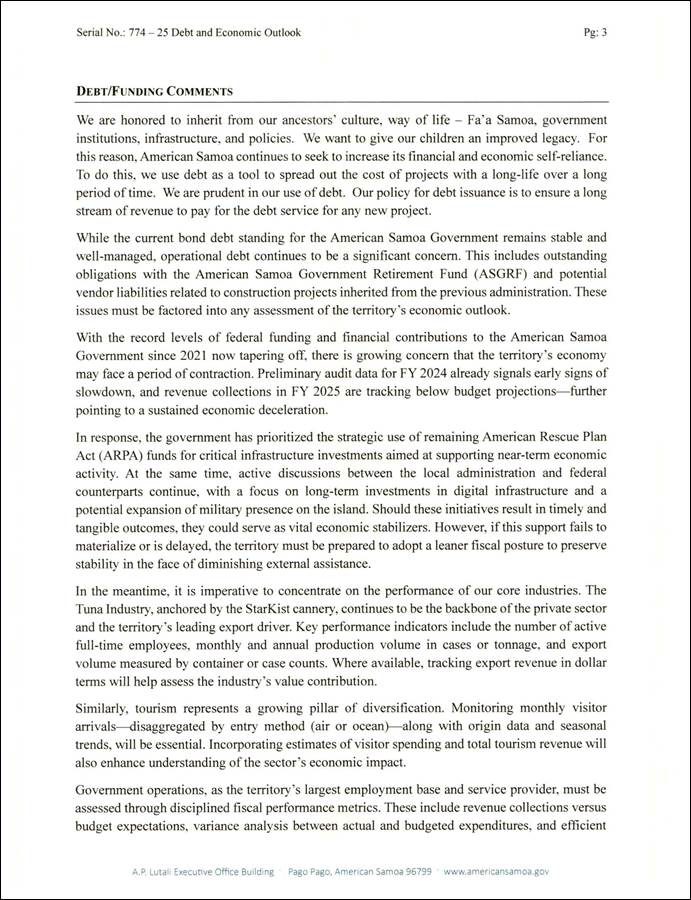
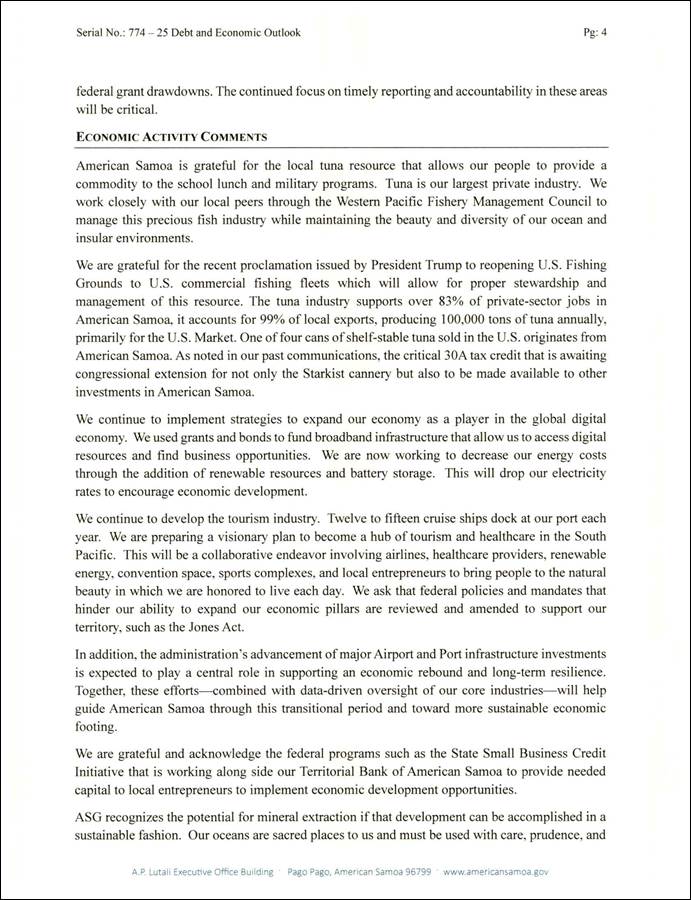
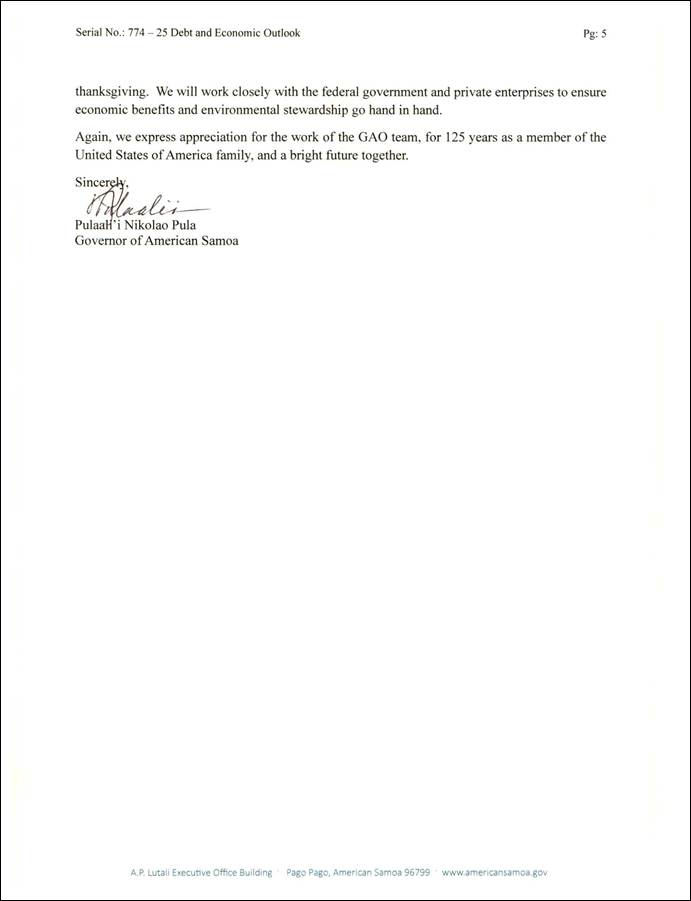
GAO Contacts
Yvonne D. Jones,jonesy@gao.gov
Latesha Love-Grayer,lovegrayer@gao.gov
Staff Acknowledgments
In addition to the contact named above, Joyee Dasgupta and Kathleen Padulchick (Assistant Directors), Katherine Morris (Analyst in Charge), Pedro Almoguera, Mike Bechetti, Harry Bernholz, Britt Bovbjerg, Ann Czapiewski, Lynda Downing, Colleen Heywood, Zachary Kinger, Amalia Konstas, Katya E. Rodriguez, and Andrew J. Stephens made key contributions to this report.
The Government Accountability Office, the audit, evaluation, and investigative arm of Congress, exists to support Congress in meeting its constitutional responsibilities and to help improve the performance and accountability of the federal government for the American people. GAO examines the use of public funds; evaluates federal programs and policies; and provides analyses, recommendations, and other assistance to help Congress make informed oversight, policy, and funding decisions. GAO’s commitment to good government is reflected in its core values of accountability, integrity, and reliability.
Obtaining Copies of GAO Reports and Testimony
The fastest and easiest way to obtain copies of GAO documents at no cost is through our website. Each weekday afternoon, GAO posts on its website newly released reports, testimony, and correspondence. You can also subscribe to GAO’s email updates to receive notification of newly posted products.
Order by Phone
The price of each GAO publication reflects GAO’s actual cost of production and distribution and depends on the number of pages in the publication and whether the publication is printed in color or black and white. Pricing and ordering information is posted on GAO’s website, https://www.gao.gov/ordering.htm.
Place orders by calling (202) 512-6000, toll free (866) 801-7077,
or
TDD (202) 512-2537.
Orders may be paid for using American Express, Discover Card, MasterCard, Visa, check, or money order. Call for additional information.
Connect with GAO
Connect with GAO on X,
LinkedIn, Instagram, and YouTube.
Subscribe to our Email Updates. Listen to our Podcasts.
Visit GAO on the web at https://www.gao.gov.
To Report Fraud, Waste, and Abuse in Federal Programs
Contact FraudNet:
Website: https://www.gao.gov/about/what-gao-does/fraudnet
Automated answering system: (800) 424-5454
Media Relations
Sarah Kaczmarek, Managing Director, Media@gao.gov
Congressional Relations
A. Nicole Clowers, Managing Director, CongRel@gao.gov
General Inquiries
[1]Pub. L. No. 114-187, § 411, 130 Stat. 549, 594–595 (2016).
[2]GAO, U.S. Territories: Public Debt Outlook - 2023 Update, GAO‑23‑106045 (Washington, D.C.: June 29, 2023); U.S. Territories: Public Debt Outlook- 2021 Update, GAO‑21‑508 (Washington, D.C.: June 30, 2021); U.S. Territories: Public Debt Outlook-2019 Update, GAO‑19‑525 (Washington, D.C.: June 28, 2019); and U.S. Territories: Public Debt Outlook, GAO‑18‑160 (Washington, D.C.: Oct. 2, 2017).
[3]Gross domestic product (GDP) measures the value of goods and services produced inside a country, or for the purpose of this report, a territory.
[4]Government-wide financial statements include both the Statement of Net Position and Statement of Activities. We also reviewed related audited note disclosures.
[5]Component units can also be other organizations for which the nature and significance of their relationship with a primary government are such that exclusion would cause the reporting entity’s financial statements to be misleading or incomplete. Some component units, despite being legally separate from the primary government, are so intertwined with the primary government that they are, in substance, the same as the primary government and are reported as part of the primary government in the government-wide financial statements. These component units are referred to as blended component units. In this report, when we mention component units, we are referring to discretely presented component units, or those for which financial data are reported separately on the government-wide financial statements.
[6]We report the revenues and expense data in nominal terms, meaning that the values are not adjusted for inflation.
[7]BEA reports GDP on a calendar year basis. We converted BEA’s GDP estimates to a fiscal year beginning on October 1 to allow for comparison with financial indicators that are reported on a fiscal year basis. When analyzing a territory’s GDP over time, we use real GDP, which has been adjusted for inflation. We also calculated the average annual growth rate over periods of 5 fiscal years to describe recent trends in each territory’s economic condition.
[8]While GDP measures the value of goods and services produced inside a country, or for the purpose of this report, a territory, GNP measures the value of goods and services produced by its residents. GNP includes production from residents abroad and excludes production by foreign companies in a country. In Puerto Rico, GDP has consistently been greater than GNP. This means that production by foreign companies in Puerto Rico is larger than production by Puerto Rican residents in the territory and abroad. For this reason, according to the U.S. Department of the Treasury, GNP is generally a more representative measure of Puerto Rico’s economic activity than GDP.
[9]The Single Audit Act, as implemented through Office of Management and Budget’s single audit guidance, requires nonfederal entities that spend $1 million or more in federal awards in a year to undergo a single audit or, in limited circumstances, a program-specific audit. 31 U.S.C. § 7502; 2 C.F.R. § 200.501. Guam, USVI, CNMI, and American Samoa all undergo single audits in accordance with the Single Audit Act. Many of Puerto Rico’s agencies and component units undergo single audits; however, the territory’s primary government as a whole does not currently receive a single audit. Puerto Rico issues annual audited government-wide financial statements which include its primary government and component units.
[10]The single audit reporting package includes audited financial statements and other required reports from the audited entity and its independent auditor. 31 U.S.C. §§ 7501–7506; 2 C.F.R. §§ 200.512(c), 200.515. Guam, USVI, CNMI, and American Samoa all have a September 30 fiscal year end and Puerto Rico has a June 30 fiscal year end. Single audit reporting packages must be submitted to the Federal Audit Clearinghouse (FAC) within the earlier of 30 calendar days after receipt of the auditor’s report(s), or 9 months after the end of the period under audit. 31 U.S.C. § 7502(h). For the purposes of this report, we used the date 9 months after the end of the period under audit to determine timely submission. Since Puerto Rico does not submit single audit reporting packages to FAC, we used the date of the auditor’s report to determine timeliness for this territory.
[11]Generally, the opinion units related to the government-wide financial statements include the primary government’s governmental activities and business-type activities and the aggregate discretely presented component units.
[12]See GAO, Puerto Rico: Factors Contributing to the Debt Crisis and Potential Federal Actions to Address Them, GAO‑18‑387 (Washington, D.C.: May 9, 2018).
[13]See for examples GAO‑23‑106045, GAO‑21‑508, and GAO‑19‑525.
[14]GAO, COVID-19: U.S. Territory Experiences Could Inform Future Federal Relief, GAO‑23‑106050 (Washington, D.C.: Sept. 19, 2023).
[15]International Monetary Fund, Government Cash Management Under Fiscal Stress, Special Series on Fiscal Policies to Respond to COVID-19 (Apr. 29, 2020).
[17]See GAO, Retirement Security: The U.S. Virgin Islands’ Pension Plan Faces Risks Paying Government Employee Benefits, GAO‑24‑105862 (Washington, D.C.: Apr. 17, 2024), GAO‑23‑106045, and GAO‑21‑508.
[18]In this report we examine each territory’s net pension liability and other postemployment benefits liability. A net pension liability is the difference between the total pension liability (the present value of projected benefit payments to employees based on their past service) and the assets (mostly investments reported at fair value) set aside in a trust and restricted to paying benefits to current employees, retirees, and their beneficiaries. CNMI and American Samoa do not report any liabilities related to other postemployment benefits on the territories’ Statements of Net Position.
[19]Debt restructuring is a process that allows a debtor to negotiate new terms for their debt with a creditor. This can involve changing the interest rate of the debt or the amount of the debt.
[20]PROMESA established two debt restructuring processes under Titles III and VI respectively. Title III is similar to municipal bankruptcy under Chapter 9 of the U.S. Bankruptcy Code. Title VI provides a process by which the debtors and creditors can negotiate and vote on an agreement with less of a role played by a court. Pub. L. No. 115-187, §§ 301–317, 601–602, 130 Stat. at 577–585, 603–609.
[21]As discussed later in this report, FOMB was established by PROMESA to help Puerto Rico achieve fiscal responsibility and access to capital markets. Pub. L. No. 114-187, §101, 130 Stat. at 553–557.
[22]The most recently available GDP and GNP data from the Puerto Rico Planning Board are for 2024. GDP data prior to 2014 are not comparable due to a methodology change. Puerto Rico’s nominal GDP in fiscal year 2024 was $125.8 billion, which reflects prices current at the time. When comparing GDP over time, we adjust the data for inflation so that all figures are in a consistent year’s values to ensure that our comparison is not influenced by changes in inflation.
[23]The Puerto Rico Economic Activity Index is produced by the Economic Development Bank for Puerto Rico. The index measures economic activity in Puerto Rico using economic indicators and is highly correlated to Puerto Rico’s real GNP and annual growth rates, though is not a direct measurement of Puerto Rico’s GNP.
[24]48 U.S.C. §§ 2141, 2144. The Governor of Puerto Rico is required to submit to FOMB newly enacted territorial laws along with certain estimates, findings, and certifications of consistency with the fiscal plan. 48 U.S.C. § 2144(a)(1), (2). FOMB, after sending required notification that a law is significantly inconsistent with the fiscal plan, is to direct Puerto Rico’s government to eliminate the inconsistency or provide an explanation FOMB finds reasonable and appropriate. 48 U.S.C. § 2144(a)(4). Failure to comply with this FOMB direction authorizes FOMB to take such action as it considers necessary, consistent with PROMESA, to ensure that the enactment or enforcement of the law will not adversely affect the territorial government’s compliance with the Fiscal Plan, including preventing the enforcement or application of the law. 48 U.S.C. § 2144(a)(5). Additionally, if the governor submits a request to the legislature for the reprogramming of any amounts provided in a certified budget, the governor shall submit such request to FOMB, which shall analyze whether the proposed reprogramming is significantly inconsistent with the budget and submit its analysis to the legislature as soon as practicable after receiving the request. 48 U.S.C. § 2144(c)(1). The legislature may not adopt a reprogramming, and no officer or employee of the territorial government may carry out any reprogramming, until FOMB has provided the legislature with an analysis that certifies such reprogramming will not be inconsistent with the fiscal plan and budget. 48 U.S.C. § 2144(c)(2).
[25]Act 41-2024 would have set a base salary of $12 per hour for school cafeteria employees in the School Dining Division of the Puerto Rico Department of Education, costing $21 million per fiscal year according to FOMB. In a letter communicating its determination, FOMB states that the act is inconsistent with the fiscal plan, was submitted without a formal estimate or certification, and is a reprogramming enacted without prior FOMB approval.
[26] Tax supported debt includes debt issued by the commonwealth where the payment source is the commonwealth’s collections, as well as debt issued by any government entity that is guaranteed, secured, or payable from these collections. The Debt Management Policy excludes certain types of debt from this definition, such as short-term tax revenue anticipation notes and debt issued in response to a natural disaster. For a more detailed definition see Puerto Rico Fiscal Agency and Financial Advisory Authority, Puerto Rico Debt Management Policy, (San Juan, PR:Mar. 9, 2022).
[27]Fin. Oversight & Mgmt. Bd. for P.R. v. U.S. Bank N.A. (In re Fin. Oversight & Mgmt. Bd. for P.R.), 104 F.4th 367 (1st Cir. 2024) (June 12, 2024, opinion withdrawn and replaced with revised opinion dated Nov. 13, 2024).
[28]Financial Oversight and Management Board for Puerto Rico, Annual Report 2024 (San Juan, PR: Jan. 22, 2025).
[29]We are conducting a separate review that examines issues with Puerto Rico’s electricity grid in more depth.
[30]Financial Oversight and Management Board for Puerto Rico, February 2025 Fiscal Plan for the Puerto Rico Electric Power Authority (San Juan, PR: Feb. 6, 2025).
[31]“Puerto Rico Territory Energy Profile,” US Energy Information Administration, last modified April 17, 2025, .https://www.eia.gov/state/print.php?sid=RQ.
[32]Departamento de Recursos Naturales Y Ambientales. El Costo de la Inacción (September 2024).
[33]We refer to Puerto Rico’s pension-related liabilities as total net pension liabilities in this report. This amount is the sum of the primary government’s total pension liability and component units’ total pension liability, net pension obligation, and net pension liability.
[34]While many of Puerto Rico’s agencies and component units individually receive single audits, the territory does not receive a single audit at the primary government level. Therefore, many reports that are included in the single audit reporting package for the other territories were not available for Puerto Rico, such as the auditor’s Report on Compliance for Each Major Federal Program and Schedule of Findings and Questioned Costs. To gain an understanding of Puerto Rico’s federal award audit opinions, audit findings, and questioned costs, we reviewed the latest single audit reporting packages that were available for Puerto Rico’s Departments of Education (fiscal year 2022), Health (fiscal year 2023), and Labor and Human Resources (fiscal year 2023).
[35]Puerto Rico’s fiscal year 2016 through fiscal year 2020 audited financial statements were issued between 2 to 3 years after their respective fiscal year ends.
[36]An auditor expresses a disclaimer of opinion on an opinion unit’s financial statements when they are unable to obtain sufficient appropriate audit evidence on which to base the opinion and conclude that the possible effects on the financial statements of undetected misstatements, if any, could be both material and pervasive.
[37]The government of Guam’s credit rating was upgraded to Baa3 from Ba1. Moody’s Baa bonds are considered medium-grade and are subject to moderate credit risk, while Ba bonds are considered speculative and are subject to substantial credit risk.
[38]According to S&P, the positive outlook reflects a one-in-three chance that S&P will raise its rating of the government of Guam’s general obligation debt within the next 2 years.
[39]S&P rated the Guam’s general obligation bonds BB-, Guam’s business privilege tax bonds and section 30 revenue bonds BB, and Guam’s apportions-backed certificates of participation B+.
[40]We could not calculate the 2023 percentage of debt to GDP because GDP data for 2023 are not available. In fiscal year 2022, Guam’s total public debt was $2.6 billion, or about 38 percent of the territory’s GDP.
[41]The most recent GDP data for the territories from the Bureau of Economic Analysis are from 2022. Guam’s nominal GDP in fiscal year 2022 was $6.7 billion, which reflects prices current at the time. When comparing GDP over time, we adjust the data for inflation so that all figures are in a consistent year’s values to ensure that our comparison is not influenced by changes in inflation.
[42]These numbers are the sums of amounts for the Department of Defense’s Military Construction and Family Housing accounts for fiscal years 2014-2025. See Department of Defense, Budget Materials, Construction Programs (C-1), Fiscal Years 2016, 2019, 2022, 2025 (Washington, D.C.: February 2015, February 2018, May 2021, March 2024).
[43]We could not calculate the 2023 percentage of pension and postemployment benefits to GDP because GDP data for 2023 are not available. In fiscal year 2022, Guam’s liability for both pensions and postemployment benefits for the primary government and component units was $4.1 billion, 61 percent of its 2022 GDP.
[44]A material weakness in internal control over financial reporting is a deficiency, or a combination of deficiencies, in internal control such that there is a reasonable possibility that a material misstatement of the entity’s financial statements will not be prevented or detected and corrected on a timely basis. A material weakness in internal control over compliance is a deficiency, or a combination of deficiencies, such that there is a reasonable possibility that material noncompliance with a type of compliance requirement of a federal program will not be prevented, or detected and corrected, on a timely basis.
[45]Fiscal year 2023 federal award expenditure and questioned cost amounts, if any, for Guam’s Department of Education, the GovGuam Retirement Fund, and Guam’s discretely presented component units are reported separately and have been excluded from the totals presented in our report.
[46]Moody’s noted that it withdrew its rating because of insufficient information to support maintaining it. Prior to the withdrawal, Moody’s had given the territory a Caa3 rating, which signifies poor quality with very high credit risk, but noted that it had a stable outlook. Moody’s Ratings, Rating Action: Moody’s Announces Withdrawal of U.S. Virgin Islands’ Issuer Rating (New York: Mar. 23, 2023).
[47]In fiscal years 2019, 2020, and 2021, USVI received a disclaimer of opinion on its component units for, in part, omitting some component unit financial information and including unaudited component unit financial information. These reported issues could have a material effect on the component unit public debt amounts included in our report.
[48]In fiscal years 2019, 2020, and 2021, USVI received a qualified audit opinion on its governmental activities and a disclaimer of opinion on its business-type activities, in part, because it did not properly maintain documentation to support a number of the primary government’s account balances and financial activities. During these years, USVI also received a disclaimer of opinion on its component units for, in part, omitting some component unit financial information, including unaudited component unit financial information, and because auditors found several issues related to the accounting and documentation of other component unit revenue and expenses. These reported issues could have a material effect on the revenue and expenses included in our report.
[49]In 2020 and 2021, the U.S. federal government issued $931 billion in direct payments to individuals to ease financial stress due to the COVID-19 pandemic. For more details, see GAO, Stimulus Checks: Direct Payments to Individuals during the COVID-19 Pandemic, GAO‑22‑106044 (Washington, D.C.: June 29, 2022).
[50]The Emergency Home Repairs Program funded repairs for homes affected by Hurricanes Maria and Irma.
[51]The most recent GDP data for the territories from the Bureau of Economic Analysis are from 2022. USVI’s nominal GDP in fiscal year 2022 was $4.6 billion, which reflects prices current at the time. When comparing GDP over time, we adjust the data for inflation so that all figures are in a consistent year’s values to ensure that our comparison is not influenced by changes in inflation.
[52]EY-Parthenon, U.S. Virgin Islands Water and Power Authority (“WAPA”): Initial Assessment Report to the Virgin Islands Public Finance Authority (Jan. 29, 2025).
[53]In April 2024 USVI’s governor declared a state of emergency to access funds from the territory’s Budget Stabilization Fund. See, V.I. Code tit. 33, § 3100m(d). The government used these funds to clear more than $11 million in debts owed to WAPA by key semi-autonomous government entities.
[54]U.S. Virgin Islands Economic Development Authority, U.S. Virgin Islands: Vision 2040: Our Community, Our Economy, Our Future (Mar. 30, 2021).
[55]“Fully funded” is defined as at least 100 percent funded, or a plan without an unfunded liability—that is, plan assets are the same as or larger than plan liabilities.
[56]GAO, Retirement Security: The U.S. Virgin Islands’ Pension Plan Faces Risks Paying Government Employee Benefits, GAO‑24‑105862 (Washington, D.C.: Apr. 17, 2024).
[57]26 U.S.C. § 7652(f).
[58]In fiscal years, 2019, 2020, and 2021, USVI received a disclaimer of opinion on its component units for omitting some component unit financial information, including unaudited component unit financial information, and because auditors found the financial statements of one component unit did not report a net pension liability and related pension information as required by generally accepted accounting principles. These reported issues could have a material effect on the net pension and other postemployment benefit liability amounts included in our report.
[59]An auditor expresses a qualified opinion on an opinion unit’s financial statements when they either: (1) conclude that misstatements, individually or in the aggregate, are material but not pervasive to the financial statements after obtaining sufficient appropriate audit evidence; or (2) are unable to obtain sufficient appropriate audit evidence on which to base the opinion, but conclude that the possible effects on the financial statements of undetected misstatements, if any, could be material but not pervasive. An auditor expresses a disclaimer of opinion on an opinion unit’s financial statements when they are unable to obtain sufficient appropriate audit evidence on which to base the opinion and conclude that the possible effects on the financial statements of undetected misstatements, if any, could be both material and pervasive.
[60]A material weakness in internal control over financial reporting is a deficiency, or a combination of deficiencies, in internal control such that there is a reasonable possibility that a material misstatement of the entity’s financial statements will not be prevented or detected and corrected on a timely basis.
[61]Fiscal year 2021 questioned cost amounts, if any, for some of USVI’s organizational units are reported separately and have been excluded from the totals presented in our report.
[62]Johnson v. Inos, No. 09-00023 (D.N. Mar. I. Aug. 6, 2013) (final amended stipulation and agreement of settlement). In addition to the settlement plan, CNMI allocated $25 million of casino license fees to fund the restoration of the 25 percent reduction of the retirees’ and beneficiaries’ pensions, among other purposes. N. Mar. I. Pub. L. 18-56, § 7 (2014). The provision of law providing for the allocation was repealed in 2017. N. Mar. I. Pub. L. 20-10, § 2 (2017).
[63]Officials stated in March 2025 that they planned to issue CNMI’s fiscal year 2022 single audit reports in May 2025 and the fiscal year 2023 single audit reports in September 2025. As of June 1, 2025, CNMI’s fiscal year 2022 and 2023 single audit reports were not available on the Federal Audit Clearinghouse.
[64]According to Moody’s 2020 report, the Ba3 rating reflected CNMI’s small economy that is concentrated in tourism, vulnerable to natural disasters, and facing significant pension liabilities.
[65]In fiscal years 2019, 2020, and 2021, CNMI received an adverse opinion on its component units due to omission of component unit data required by generally accepted accounting principles. For example, these most recent financial statements have not included financial information from one of its major component units, Commonwealth Healthcare Corporation. Additionally, in fiscal years 2020 and 2021, CNMI received a disclaimer of opinion on its governmental activities, in part, because it was unable to provide sufficient appropriate audit evidence to support a substantial amount of the primary government’s account balances and financial activities. These reported issues could have a material effect on the public debt, revenue, expense, and resulting net surplus/deficit amounts included in our report.
[66]The most recent GDP data for the territories from the Bureau of Economic Analysis are from 2022. CNMI’s nominal GDP in fiscal year 2022 was about $1 billion, which reflects prices current at the time. When comparing GDP over time, we adjust the data for inflation so that all figures are in a consistent year’s values to ensure that our comparison is not influenced by changes in inflation.
[67]See our series of reports on workforce trends in CNMI. GAO, Commonwealth of the Northern Mariana Islands: Greater Transparency Could Improve Worker Ratio Reports, GAO‑24‑106698 (Washington, D.C.: Feb. 13, 2024); Commonwealth of the Northern Mariana Islands: Recent Workforce Trends and Wage Distribution, GAO‑22‑105271 (Washington, D.C.: Feb. 8, 2022); and Commonwealth of the Northern Mariana Islands: Recent Workforce Trends, GAO‑20‑305 (Washington, D.C.: Feb. 13, 2020).
[68]To provide for a transition from the CNMI immigration system to the U.S. immigration system, the Consolidated Natural Resources Act of 2008 provided authority for the Department of Homeland Security to establish the CNMI-Only Transitional Worker (CW-1) program, which it did in 2011. Pub. L. No. 110-229, §§ 701–705, 122 Stat. 754, 853–867 (2008). Through the program, employers petition for nonimmigrant CW-1 permits that allow foreign workers who meet certain requirements to work temporarily in CNMI. In 2014, the transition period for the CW-1 program was extended through December 31, 2019. Consolidated and Further Continuing Appropriations Act, 2015, Pub. L. No.113-235, § 10, 128 Stat. 2130, 2134 (2014). An amendment in 2018 extends the CW-1 program through December 31, 2029, defines the number of permits the Department of Homeland Security may issue annually, and reduces that number each year until the end of the transition period. Northern Mariana Islands U.S. Workforce Act of 2018, Pub. L. No. 115-218, § 3, 132 Stat. 1547, 1547-1555 (2018).
[69]In fiscal years 2019, 2020, and 2021, CNMI received a disclaimer of opinion on its governmental activities, in part, because it did not properly follow certain generally accepted accounting principles related to pensions. These reported issues could have a material effect on the primary government net pension liability amounts included in our report.
[70]An auditor expresses an adverse opinion on an opinion unit’s financial statements when, having obtained sufficient appropriate audit evidence, they conclude that misstatements, individually or in the aggregate, are both material and pervasive to the financial statements. An auditor expresses a disclaimer of opinion on an opinion unit’s financial statements when they are unable to obtain sufficient appropriate audit evidence on which to base the opinion and conclude that the possible effects on the financial statements of undetected misstatements, if any, could be both material and pervasive.
[71]Fiscal year 2021 federal award expenditure and questioned cost amounts, if any, for the Northern Mariana Islands Retirement Fund and CNMI’s discretely presented component units are reported separately and have been excluded from the totals presented in our report.
[72]We could not calculate the 2023 percentage of debt to GDP because GDP data for 2023 are not available. In fiscal year 2022, American Samoa’s total public debt was $152.4 million, or about 18 percent of the territory’s GDP.
[73]The most recent GDP data for the territories from the Bureau of Economic Analysis are from 2022. American Samoa’s nominal GDP in fiscal year 2022 was $840.8 million, which reflects prices current at the time. When comparing GDP over time, we adjust the data for inflation so that all figures are in a consistent year’s values to ensure that our comparison is not influenced by changes in inflation.
[74]StarKist Co. has operated StarKist Samoa tuna cannery in American Samoa since 1963. Due to closures of other canneries between 2007 and 2018, it is the only tuna cannery still operating in American Samoa. See GAO‑23‑106045.
[75]The credit reduces federal taxes on income earned by qualifying U.S. corporations investing in American Samoa; qualifying American Samoa tuna canneries have claimed the credit. See Pub. L. No. 109-432, § 119, 120 Stat. 2922, 2942 (2006). As of February 2025, the credit has been extended to tax years starting before January 1, 2022. Pub. L. No. 116-260, div. EE, § 139(a), 134 Stat. 1182, 3054 (2020).
[76]For more information, see GAO, American Samoa: Economic Trends, Status of the Tuna Canning Industry, and Stakeholders’ Views on Minimum Wage Increases, GAO‑20‑467 (Washington, D.C: June 11, 2020).
[78]The Pacific Islands Forum brings together countries and territories in the Pacific Region together to address pressing issues and challenges, and foster collaboration and cooperation in pursuit of shared goals. The Forum works on issues related to peace and security, climate risks and disasters, and technology.
[79]Am. Samoa Pub. L. No. 37-10 (2022), codified at Am. Samoa Code §§ 7.1433, 7.1434.
[80]We could not calculate the 2023 percentage of net pension liabilities to GDP because GDP data for 2023 are not available. In fiscal year 2022, American Samoa’s net pension liability was $248.6 million, or about 30 percent of the territory’s GDP.
[81]An auditor expresses a qualified opinion on an opinion unit’s financial statements when they either: (1) conclude that misstatements, individually or in the aggregate, are material but not pervasive to the financial statements after obtaining sufficient appropriate audit evidence; or (2) are unable to obtain sufficient appropriate audit evidence on which to base the opinion, but conclude that the possible effects on the financial statements of undetected misstatements, if any, could be material but not pervasive.
[82]A material weakness in internal control over financial reporting is a deficiency, or a combination of deficiencies, in internal control such that there is a reasonable possibility that a material misstatement of the entity’s financial statements will not be prevented or detected and corrected on a timely basis. The financial close process involves verifying and adjusting account balances at the end of an accounting cycle (often the end of the quarter or end of year) to produce financial reports representative of an entity’s financial position as of a certain date.
[83]Fiscal year 2023 questioned cost amounts, if any, for the Development Bank of American Samoa, American Samoa Power Authority, American Samoa Community College, American Samoa Telecommunications Authority, and American Samoa Medical Center Authority are reported separately and have been excluded from the totals presented in our report.




